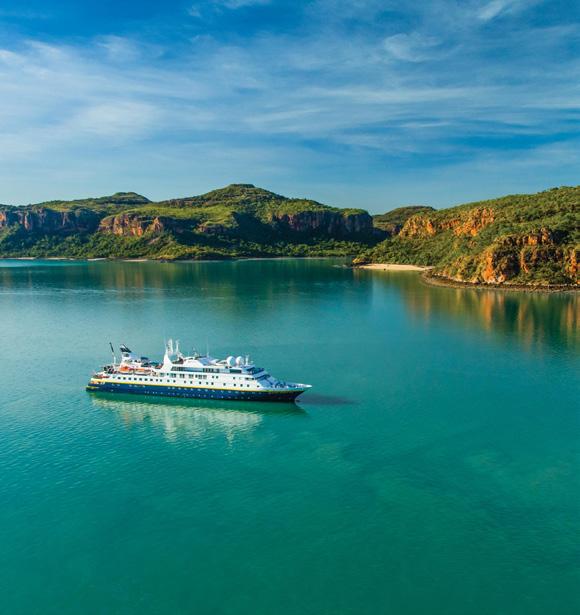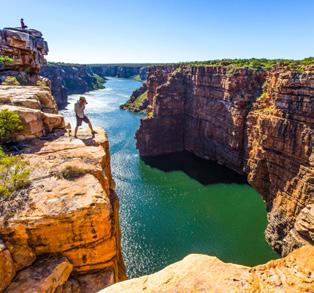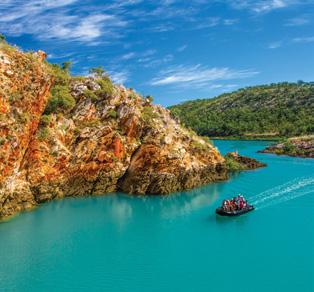 SUMMER 2023 Australian Museum magazine
The crucial role of sharks Spectacular specimens on display in the new Minerals gallery
SUMMER 2023 Australian Museum magazine
The crucial role of sharks Spectacular specimens on display in the new Minerals gallery
 SUMMER 2023 Australian Museum magazine
The crucial role of sharks Spectacular specimens on display in the new Minerals gallery
SUMMER 2023 Australian Museum magazine
The crucial role of sharks Spectacular specimens on display in the new Minerals gallery
E xplore
ISSN 1833-752X
Summer 2023
Explore, the news and events magazine of the Australian Museum and Australian Museum Members, is published biannually.
Copyright Unless otherwise credited, all text and images appearing in Explore are copyright © Australian Museum, 2022. Except as permitted under the Copyright Act 1968, you may not reproduce or copy any part of this publication without the written permission of the Australian Museum. Please contact the editor for further information.
Views expressed are not necessarily those of the Museum.
Editor Alice Gage
Design Jeremy Austen
Production Jenny Hooker
Printing Special T
We welcome your feedback, comments and enquiries. Email the editor at: alice.gage@australian.museum
Australian Museum 1 William Street Sydney NSW 2010 Open daily 10am-5pm 02 9320 6000 (switch) 02 9320 6225 (Members) www.australian.museum
Australian Museum Trust President David Armstrong Director & CEO Kim McKay AO
Environmental responsibility Explore is printed on Revive, a 100% recycled paper. australian.museum
Cover image: Great Hammerhead, Sphyrna mokarran. Photo by Tomas Kotouc, Shutterstock
Right: Banded Iron Formation, Pilbara, Western Australia, acquired 2021, now on display in the Minerals gallery.
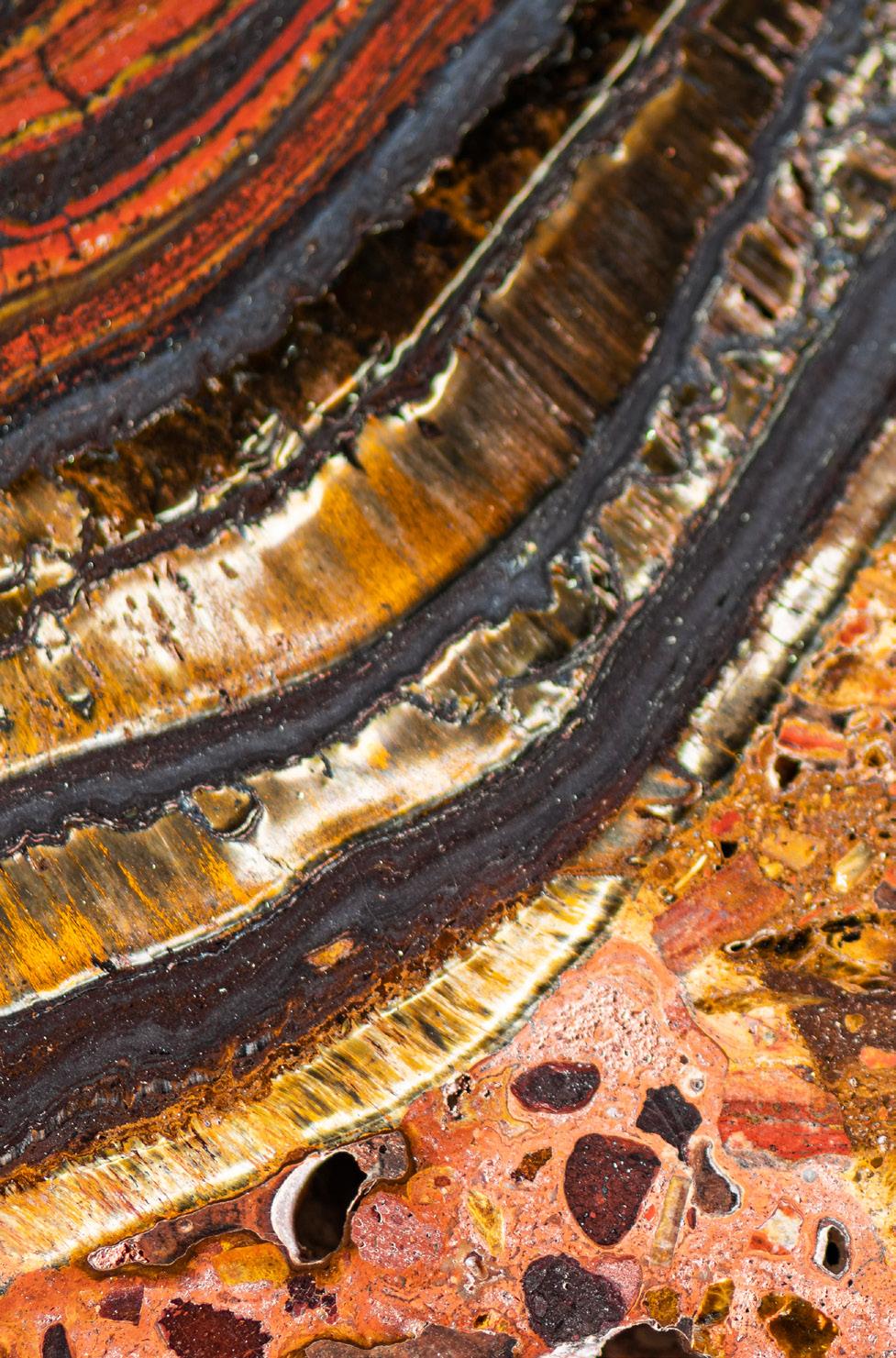 Photo by Abram Powell
Photo by Abram Powell
The Australian Museum acknowledges the Gadigal people as the Custodians of the land on which the Museum stands. We pay our respect to Aboriginal Elders and recognise their continuous connection to Country.
The Australian Museum is principally funded by the NSW Government in association with Create NSW.
Contents
4 What’s on 6 Welcome Kim McKay AO 7 Museum news 12 Expedition: Understanding a South Pacific jewel Meagan Warwick, Paul Flemons 17 New acquisition: Papa He’e Nalu Hawaiian surfboards Logan Haronga-Metcalfe 18 Why sharks? Why now? Trevor Ahearn 20 Kids’ feature: Sharks 27 New acquisition: The Coughran Crayfish Collection Prof Shane Ahyong 28 Tiny specimens Alice Gage 32 Photo gallery: The spectacular, ancient crystals of the Minerals gallery Ross Pogson 40 My Museum: Ross Pogson 42 New acquisition: One person’s roadkill is another’s scientific treasure Dane Trembath 44 Around the Museum

Summer at the AM
Exhibitions
Sharks
Do you dare dive in? An interactive exhibition that traverses shark evolution, the significance of sharks to First Nations and Pasifika peoples and the importance of museum science.

Now showing – first visit free for AM Members, 50% off subsequent visits
New — Minerals
A new permanent gallery featuring 1800 magnificent mineral and rock specimens. Visitors can enjoy their colours, shapes, symmetry and exotic origins – each one with its own story.

Now showing, free entry
Coming soon –Barka: The Forgotten River
Meet the Barka (Darling River) through the eyes of Barkandji Elder Uncle Badger Bates and artist Justine Muller. Opening 18 March, free entry

Members events
Special events
Erth’s Shark Dive
Come close to the Great White without getting wet at this shark cage dive experience, created by world-renowned puppeteers Erth and presented as part of Sydney Festival.
3-29 January
Waranara Tours
An engaging, one-hour experience with First Nations guides who share personal connections, stories and knowledge through key objects in the First Nations Galleries.
Recycled Art Weaving Workshops
Guided by local artists and facilitators from the Ghost Net Collective, learn to weave using recycled materials discarded in our ocean and collaborate on a large-scale woven artwork.
14 & 15 January
Ngalu Warrawi
Monday Meditation
Ease into your week with a clear mind and fresh perspective in these regular meditation sessions, led by TV presenter, yogi and storyteller Rachael Coopes.
First Monday of the month AM Members only
Animal Yoga
Kids can strike some animalinspired poses in this playful yoga workshop, set in the incredible Wild Planet gallery.

First Monday of the month AM Members only
Wednesdays, Saturdays & Sundays from 4 January
Summer School Holidays
Be a scientist for a day, get sketching with our scientific illustration workshops and delve into the world of sharks with science shows and drop-in art sessions.
9-24 January
For more information on what’s happening at the AM visit australian.museum
Marri
(We Stand Strong)
A free, after-hours event of live music, conversations, workshops, tours and performances celebrating the continued resistance and ongoing resilience of First Nations Peoples.
25 January
Ngalu
Warrawi Marri (We Stand Strong) Film Series
A curated series of contemporary truth-telling films, highlighting the histories, perspectives and challenging personal journeys of First Nations peoples and their communities.
26 January
Twilight Bites Talk Series
A monthly after-hours series of canapés and conversation with renowned shark scientists and cultural experts.
1 February, 1 March, 5 April
Five Things: How to Help our Native Bees
Learn five things you can do to bring native bees into your garden, as native bee taxonomist Michael Batley discusses their importance, beauty and diversity.
4 February 2023
Early Birds
People with autism and other access requirements can explore the AM in a reduced sensory, relaxed and supportive atmosphere before it opens to the general public.
11 February
Sydney World Pride
Celebrate Sydney World Pride at the AM with a range of events and interactive experiences, including a very special edition of Jurassic Lounge.
17 February – 5 March
Erth’s Shark Dive
For over 30 years, Erth’s puppetry-based theatrical productions and innovative community projects have challenged and inspired audiences around the world, driven by a special interest in natural history, First Nations stories, sociology and urban mythology. Today the company is internationally recognised as an innovator of physical and visual theatre, and a creator of brave, unbridled work for children.
This summer, the AM is pleased to host Erth’s newest work, the interactive installation, Erth’s Shark Dive.
After donning headphones, small groups of participants will enter a custom-made “shark cage”. From here they can choose their own personalised audio adventure as they come face-to-face with Erth’s majestic shark puppets.

Presented in partnership with the Australian Museum and Sydney Festival.
3–29 January 20 minutes sessions throughout the day Book online: australian.museum/event/erth-shark-dive
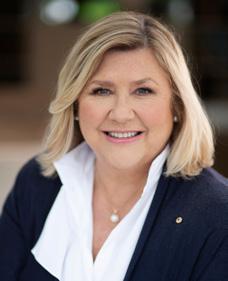
The power of community
From our award-winning exhibitions to our world-leading science, community is at the heart of everything we do at the Australian Museum.
A great example of community engagement is the recent scientific expedition to Norfolk Island, conducted by the AM in collaboration with the local Norfolk Island community, Parks Australia, the Australian Institute of Botanical Science and Auckland War Memorial Museum. The expedition has already helped confirm evidence of Polynesian settlement on Norfolk Island during the 13th and 14th CE, with even more new discoveries expected to come from the biological diversity surveys conducted by AMRI scientists.
In this issue of Explore, you’ll also read about the leadership role the AM has taken working with other cultural institutions to coordinate disaster response and assist the Lismore Art Gallery and the Richmond Rivers Historical Society after the devastating floods experienced earlier this year.
And we’re excited to have opened another new gallery for the local community to enjoy – Minerals, with more than 1800 dazzling specimens on display from our extraordinary collections. We have also produced a Minerals catalogue, Mineral Icons, which is a spectacular reference guide to the best of our collection. (AM Shop, $49.99.)
The AM is proud to be a civic space for Sydney and New South Wales and we love engaging with our ever-growing community of AM Members, as well as communities from across Australia and around the world.
I’d like to take this opportunity to welcome our new AM Members –we now have more than 40,000! We’re looking forward to sharing more great exhibitions with you in the future, with the international touring exhibition Ramses the Great and the Gold of the Pharaohs set to open in November 2023.
Your membership helps keep our doors open, advances our critical research, conserves our collection of 22 million objects and specimens and provides opportunities for community and educational engagement – thank you for your support.
I look forward to seeing you at the AM soon.
The AM expands its Executive Leadership Team
To help the AM achieve its future vision to build a new home for the beating heart of science, education, and cultural knowledge at the gateway to Sydney’s CBD, we welcomed Heather Harris and Brett Ogier to the AM’s Executive Leadership Team.
We are lucky to have Heather and Brett on the team and look forward to reaping the benefits of their broad international museum and government experience.
Heather Harris, Chief Operating Officer
In this newly created role, Heather leads the teams at the Museum responsible for commercial activities, building services, technology, people and culture, security, and legal and procurement services. Since being appointed in May 2022, Heather has also led the Master Plan development work at the Museum and a transformation programme aimed at optimising the Museum’s processes, planning, reporting and project management practices.
Heather is an experienced museum director, with extensive knowledge of strategy and policy development for museums, collections management and care, and current museum best practices and trends.

Brett Ogier, Chief Financial Officer
Brett Ogier also joined the Australian Museum in May 2022 and leads the finance division.
Brett is responsible for the Museum’s financial and risk management, financial planning processes, performance monitoring, and financial reporting to stakeholders, playing a key role in developing and implementing the AM’s finance strategy.
Brett is a Chartered Accountant and finance executive with over 20 years’ experience in financial leadership roles across listed and government entities, including the past 13 years in NSW and federal government.

Voyage to the unknown
Dr Yi-Kai Tea, Chadwick Biodiversity Research Fellow, IchthyologyIndigo waters and cerulean skies, separated by an endless horizon. For voyage participants on RV Investigator, this was reality for five weeks at sea. But the calm waters of the Cocos Keeling and Christmas Island marine parks hide an unknown complexity below. Masquerading under the cover of darkness are critters new to science, precisely the sort to pique the interest of the team aboard the Investigator.
In October, seven Australian Museum scientists boarded the CSIRO research vessel to continue our work characterising the biodiversity of some of the deepest parts of this region’s oceans.
Led by Chief Scientist, Dr Tim O’Hara, from Museums Victoria, the AM team were accompanied by fellow scientists from CSIRO, Museums Victoria Research Institute and Western Australian Museum.
Using complex, state-of-the-art bathymetry, the sea floor of the Cocos Keeling Islands and surrounding sea mounts were mapped, uncovering deep trenches, undulating sea mounts and ancient sunken volcanoes. The resulting data is the first for the region, providing a glimpse of the previously unknown topology of this biodiversity hot spot.
Top: A flying fish in waters around the RV Investigator

Above: AM scientists Dr Claire Rowe, Dr Yi-Kai Tea, Dr Penny Berents, Dr Elena Kupriyanova, Dr Ingo Burghardt, Ken Graham and Beth Flaxman aboard the Investigator

.
And a hot spot it was. In addition to mapping, the science team carried out close to 100 operations sampling water and animals from a variety of depths ranging from 300 to 5500m.
The result was a veritable plethora of creatures –some never seen before, some new for the region, all exciting. Of particular interest were organisms living in the abyssal plain, which have evolved a suite of unique qualities enabling them to thrive in these tumultuous conditions. Tripodfishes that “stand” on enormous stilt-like fins, bioluminescent lanternfishes that glow like Christmas ornaments, swimming sea cucumbers resembling headless chickens – these were just some of the many intriguing specimens uncovered living in the murky depths.
The data from this expedition will provide material for years to come. For the scientists, the work’s only just begun.
This research is supported by a grant of sea time on RV Investigator from the CSIRO Marine National Facility. The Chadwick Biodiversity Annual Fellowship is made possible by a generous bequest from Clarence E Chadwick.
Top: Bony-eared Assfish ( Acanthonus armatus) collected during the expedition

Above: Bathysaurus specimen aboard the Investigator

Photos by Yi-Kai Tea
Masquerading under the cover of darkness are critters new to science, precisely the sort to pique the interest of the team aboard the Investigator
AM conservators assist colleagues in flood zones
Heather Bleechmore, Manager, Collection Care and ConservationIn early March 2022, as devastating flood waters receded from Lismore and the Northern Rivers region of New South Wales, the Collection Care and Conservation team stepped up to coordinate the disaster response on behalf of NSW Cultural Institutions and assist two important museums in the region – the Lismore Art Gallery and the Richmond Rivers Historical Society. This was a race against time to prevent further damage to significant collection items. Unlike a bushfire, in a flood it is the period after the initial impact that can cause the most damage to material left sitting in water. Mud and silt left behind by the flood contain contaminants that embed into organic material causing cracking, warping, staining and delamination. The primary concern of rapid mould growth, which occurs in stagnant, humid environments with no ventilation, was already being observed.
Working with Museums and Galleries NSW, Create NSW and private conservation services, the NSW Cultural Institutions (comprising the AM, the Art Gallery of NSW, the Museum of Applied Arts and Sciences and other state-funded institutions) collaborated on a salvage and triage plan that started with the transport of collection material.
Left: Contaminated and muddy collection material.

Photo by Julie McCarthy
Above: Conservators examining affected paper material. Photo by Heather Bleechmore

Historical photographs, maps, posters and a collection of audio-visual material all needed drying out and assessment. Of most concern were three priceless Hannah cabinets that required early transport and gradual drying under monitored conditions to prevent further cracking and delamination of intricate woodwork. Freezer trucks were arranged to transport the contaminated collections to cold storage to buy some time –as mould was already an issue, freezing the material effectively reduced any further deterioration and allowed us to plan the next stages.
A suitable location in Sydney’s CBD was secured for the enormous task of assessing the damage across hundreds of collection items. Once relocated to this building, the collection from the Richmond Rivers Historical Society was allocated across NSW Cultural Institutions who offered specialised support in curation, assessment, documentation and stabilising treatment work to the affected collection material.
The CC&C team will continue to work with the network of preservation support for the Northern Rivers region into the new year and assist with disaster preparedness plans for future flooding.
Celebrating the life of Australian Museum former president Brian Sherman
AM
The Australian Museum honours the legacy of leading science and arts philanthropist, Brian Sherman AM.
The Australian Museum honours the legacy of leading science and arts philanthropist, Brian Sherman AM
As president of the Australian Museum Trust from 2001 to 2009, Brian ensured the AM excelled as a world-leader in scientific research. He was the founding chairperson of both the Australian Museum Foundation and the President’s Circle of donors, helping the Museum raise vital funds and continue to make a significant contribution to Sydney’s scientific and cultural life.
In December 2020, Brian was named Governor Emeritus in recognition of his $1m contribution to the Australian Museum’s major redevelopment, Project Discover, with the naming of the Brian Sherman Crystal Hall. In 2022 he received the
Brian Sherman AM presented with a Lifetime Achievement Award, August 2022.
Left to right Ondine Sherman, Emile Sherman, Brian Sherman, Dr Gene Sherman, Professor Tim Flannery, Kim McKay and Professor Kathy Belov. Photo by Tim Levy

Brian brought a depth of empathy, understanding and kindness, which the Museum will continue to carry on in his honour.
Australian Museum Research Institute Lifetime Achievement Award marking his significant contribution to animal welfare, to the advancement of science, to community and to the Museum.
“Brian Sherman’s leadership and ethics brought a new perspective to the Australian Museum’s operations. His active engagement delivered so much, including the building of the AMRI building in 2008, vastly improving AM storage facilities for millions of specimens and upgrading our scientific research facilities,” said Professor Tim Flannery, Distinguished Fellow in Climate Change.
The Australian Museum extends its condolences to the Sherman family and to the Trustees and staff of the Sherman Foundation.
Understanding a South Pacific jewel
Meagan Warwick, AMRI Project and Communications Officer Paul Flemons, Expedition Leader, Australian Museum

Located in the Pacific Ocean between New Zealand and New Caledonia is Norfolk Island, a small island with a big history and unique biodiversity. Norfolk Island was chosen by the Australian Museum for its 2022-2024 expedition – the first phase of which has just been completed.


The word “expedition” evokes many images – from famous explorers of the Antarctic to Indiana Jones. Scientists and popular culture have long been fascinated by the idea of discovery. Expeditions are at the heart of what natural history museums are all about. They are an opportunity to collect specimens, describe new species and study the incredible biodiversity of this planet – expeditions provide us with a snapshot in time of how our biodiversity is tracking, and how we can conserve it. Key to the success of expeditions is community support, knowledge, and engagement – community know their own backyard best, and their support amplifies the outcomes from scientific surveys.
In October and November 2022, Australian Museum scientists, in collaboration with the Norfolk Island community, Parks Australia, the Australian Institute of Botanical Science and the Auckland War Memorial Museum, completed Phase One of the Norfolk Island expedition. Our scientists conducted terrestrial biodiversity surveys of both native and introduced flora and fauna which involved teams from mammalogy, ornithology, herpetology, entomology and arachnology alongside botanists, and an archaeological team. The aim of the three-year expedition is to better understand the existing and evolving ecological landscape of the island, study its more remote biodiversity and help inform future management plans for the animals and plants that call it home.
Why do we go on expeditions?

Expeditions contribute to a natural history museum’s vast and unique reference collections and our collective understanding of the world’s culture and biodiversity. Norfolk Island is largely underrepresented in the Australian Museum’s collections, so the expedition provides an opportunity to learn more about threatened species and those new to science, to study how pest species such as invasive rodents are affecting the island’s biodiversity, and how we can monitor these effects in future. We cannot conserve what we do not know!
Expeditions don’t happen overnight – they are a complex and multifaceted undertaking involving years of planning and collaboration. An integral part of the process is consulting with multiple scientific teams and community ensuring knowledge exchange between organisations, community and scientific teams, including senior scientists training junior scientists in field methodologies.
Working with community
Local communities offer a wealth of knowledge of locations, species and stories. Respecting and engaging the local community in the expedition means this knowledge and our science work together to ensure we learn as much as possible about the culture and history of the area.
Prior to our arrival, we designed and promoted a week-long community engagement program. Our scientists kicked off the expedition with an opening night event at Rawson Hall, where they met with the Flora and Fauna Society, local citizen scientists, the Council of Elders and many more. Sharing their plans for the week, scientists invited community feedback, concerns and questions at the outset. The locals were exceptionally welcoming, sharing with us their species observations, inviting scientists to survey private land, sharing biosecurity concerns, and highlighting what they wanted from the expedition. Also made apparent was people’s “scientist fatigue” – of scientists coming and going from the island, without being informed of progress or results. Particularly well received was the Museum’s acknowledgement of the Polynesian and Pitcairn origins of the community, penned by Taofia Pelesasa of our First Nations team, and presented as part of Expedition Leader Paul Flemons’ opening address.
Our team hosted a daily morning café hour and afternoon lab hour, where scientists and local people could continue their dialogue. Updates were given on the local radio station, newspaper and Facebook groups. Our entomology team, Dr Helen Smith and Natalie Tees, with PhD student James Tweed from the University of Queensland, led a walk
Opposite: Norfolk Island
Left: Paul Flemons, Expedition Leader, holding a specimen jar with moth

Below: AM ornithologist Dr Richard Major and technical officer Emily Cave observing birdlife on Norfolk Island

Photos by Tom Bannigan
in the Botanic Gardens at night where people of all ages looked for spiders, beetles and all nocturnal creatures! Through these events, our scientists were able to regularly share their work and build sustainable connections with community members –resulting in increased engagement, including locals donating specimens.
The engagement program culminated with a Community Day at the end of the week. This was a three hour “show and tell” with preliminary findings (prepared specimens), equipment (our 3D scanner) and techniques (like our mist-net!). The day was a huge success, with over 50 people attending.
A unique dimension to the expedition was our education and 3D scanning program. The education program was a big hit and proved to be very effective in reaching younger generations, who may have missed out otherwise. Education Project Officer
Charlie Kingsford was at the local school teaching each year group about the role of museums, the AM’s Sharks exhibition and more. The school even thanked Charlie in the local newspaper. The 3D scanning program captured the curiosity of all ages –Charlie and Meagan Warwick scanned artefacts from the archaeological site, and at the Community Day scanned objects that locals brought in, including one family’s meteorite and the bell from the Norfolk Island Resolution, brought in by the Norfolk Island Museum.
In the field
Phase One focused on rats, bats, cats, geckos, skinks, insects, spiders, birds, snails and plants! Whether our teams were setting up mist-nets to study the diverse bird fauna before dawn, or soil sifting in the search for spiders and beetles after nightfall, Norfolk Island was abuzz with scientific activity. Our scientists worked across Norfolk Island National Park, regional council parks and private land to survey terrestrial species.
A highlight of the expedition was our trip to neighbouring Phillip Island, a fascinating example of human induced environmental collapse and recovery. Recovery began in 1980 after the last rabbit was removed – at that time, the vegetation on the island had been reduced to a single endemic hibiscus. Led by local Mark Scott, the trip out was an adventure in itself. Climbing aboard the boat whilst suspended from a crane, our scientists sailed across the water with experienced local skipper David Biggs at the helm. In a short time, our scientists were clambering up the steep slopes of the island while on the lookout for the giant venomous centipede. The team stayed overnight in the impressively comfortable Parks Australia hut. They scoured the steep slopes for insects, spiders, geckos and skinks, and set audio traps in the hope
Expeditions contribute to a natural history museum’s vast and unique reference collections and our collective understanding of the world’s culture and biodiversity.
of finding elusive bats. All were in awe of the resilience of nature and the beauty of the island’s ruggedness and omnipresent, soaring marine birds.

Another outstanding highlight of the expedition was the archaeological excavation. You never know what you’ll find when excavating – so finding an adze on the first day was exceptional! Dr Amy Mosig Way of the Australian Museum and Nicola Jorgensen of the University of Sydney, with local Neil “Snowy” Tavener, uncovered two adzes (similar to stone axes) and hundreds of flakes dating from pre-European, Polynesian settlement. Snowy connected the team with the site after finding basalt flakes on a local walking track in the national park. Prior to this, there had been only one other confirmed Polynesian site on Norfolk Island, in Emily Bay. Finding a Polynesian site on the opposite side of the Island expands the evidence we have for the Polynesian period of settlement, opening opportunities for further research. The excavation was keenly attended by a number of locals fascinated by the
island’s Polynesian history, including Arthur Evans whose parents played such a significant role in understanding the biodiversity of Norfolk and Phillip islands.
In the following months, our scientists will be analysing the data and specimens they carefully collected, clarifying the status of vertebrate and invertebrate species, native and introduced, on the main and offshore islands. Already apparent are several species new to science as well as new records for Norfolk Island, across entomology, herpetology and botany (particularly liverworts and weeds). We look forward to sharing their findings in the near future!
The Australian Museum would like to thank donors and the Australian Museum Foundation for their support of this three-phase expedition. The first phase was made possible by the generosity of the Vonwiller Foundation and Vanessa Tay.
Scientists on Phillip Island. Photo by Tom BanniganAll were in awe of the resilience of nature and the beauty of the island’s ruggedness
Papa He’e Nalu Hawaiian surfboards
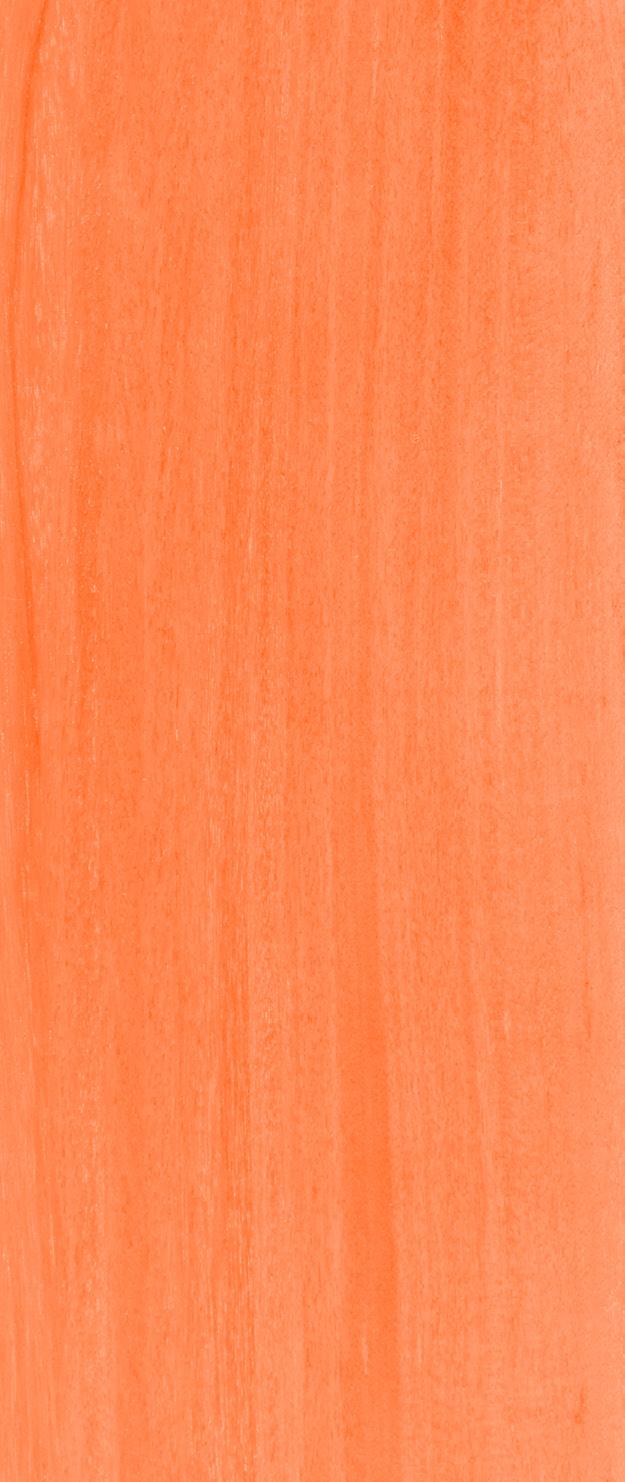
 Logan Haronga-Metcalfe Collections Officer, Pasifika Collections & Engagement
Logan Haronga-Metcalfe Collections Officer, Pasifika Collections & Engagement
I first had the opportunity to engage with Tom Pohaku Stone five years ago when I called on him at his home in Oahu, Hawaii. Tom is a softly spoken practitioner of customary surfing and a Kahuna Kālai Papa he’e nalu – an expert in surfboard construction. He described his observations on surfing and traditional techniques of working with endemic wood and I recognised his deep passion for the cultural practices of his Hawaiian homeland. Years later, the AM Pasifika team was very pleased to commission four of his Papa he’e nalu for our collection.
Handmade from Redwood and Ulu (breadfruit tree) with immense skill and care, the Papa he’e nalu display the diversity of form and purpose of Hawaiian surfboards and the unique cultural practices of the island. In Hawaii, surfing has a direct link with Ali’i (high chiefs). More of a cultural practice than a sport as it is in western nations, there is an inherent spirituality attached to surfing, and an association with flying like birds over the ocean.
The Australian Museum holds approximately 160 objects associated with the Hawaiian Islands including the Kalani’ōpu’u’s cape and Mahiole helmet replicas, canoes, fishing hooks and trumpet shells. The surfboards complement these highly valued items that relate to life in the Pacific.
This acquisition provides the opportunity to create a dialogue and enhance interest around surfing, and a unique way to contextualise Australian surfing culture and history. By juxtaposing traditional and contemporary themes, we seek to invite the audience to reflect upon the power and gravitas inherent in the objects, and the way in which that power continues to resonate in contemporary communities.
This acquisition was made possible by the Patricia Porritt Collection Acquisition Fund and the Australian Museum Foundation. The Papa he’e nalu are currently on display in Sharks .
WHY SHARKS? WHY NOW?
 Trevor Ahearn Producer, Exhibitions
Trevor Ahearn Producer, Exhibitions
Sharks are among the most fascinating animals on the planet. They were here over 400 million years ago, before dinosaurs, and have evolved to be the top predators in our oceans. They have been shaped through time by their environments and have survived five mass extinctions. As ancient as they are, they bristle with senses and are as elusive as the most high-tech of modern technology. They are mysterious and awe inspiring, and have captured the imagination of humans forever. They are respected and revered by traditional knowledge holders. Shark motifs appear in countless artworks and objects throughout the world, but especially in our region; Australia and the Pacific. Sharks are kin, they are teachers and guardians. They care for and protect people and culture. In return people must care for and protect them.
It’s for all of these reasons that the Australian Museum spent three years building the exhibition Sharks
There are about 500 species of sharks and they belong to a broad family of fish that includes rays and chimeras who all have cartilage instead of bones. The difference between a shark and a ray is that the ray’s gills are on its underside, facing directly down. They differ from chimeras because the chimera has only a single gill slit on each side. Sharks themselves are very diverse with new species still being discovered.
Many ancient sharks looked very different to our modern sharks. There were sharks with bizarre teeth arrangements like the Helicoprion, which puzzled scientists for decades. The biggest fish that ever lived was the Megalodon, which grew to a length
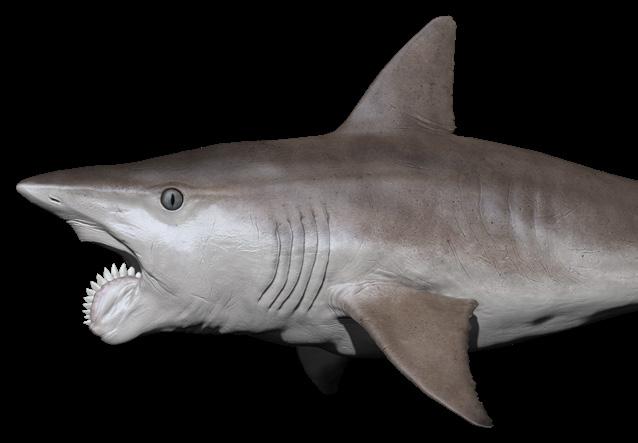
Rosalie Uaniva Havea, Principal,
of 18m. It was a relatively recent shark living only about 20 million years ago. As the world changed, environments changed and sharks adapted.
Adapting to a changing world is something sharks have been very successful at. We can tell from fossils that sharks maintained a basic body plan from very early on. This basic plan has seen sharks through the shifting of continents, the catastrophic strike of comets and the waxing and waning of ice ages. However, they may not survive humans – damaging our world is something humans have been very good at.
A foundational block in the Jenga tower of Earth’s biodiversity
Why should we care if sharks live or die? They are an apex predator, after all – wouldn’t removing them from the ocean simply allow other species to flourish? The answer is no – and this is the heart of biodiversity. Biodiversity is the Earth’s most important and complex feature – it’s what makes Earth, Earth. It is the ancient interplay between the planet’s millions of species, from bacteria in the soil to birds on the wing, that maintains a functional physical environment.
By learning a little about sharks, we’re better equipped to take care of Earth’s biodiversity.
We have been thoughtless in our caring, we have been heartless in our loving and we have been unfaithful in our commitment to the sustainable development of our environment.
Tongan Language School, SydneyOpposite: A shark swims in the waters around the RV Investigator research vessel (more on page 8). Photo by Yi-Kai Tea
Sharks as ecosystem engineers
Sharks are most famous for being apex predators. That’s important, but only a few species of sharks actually fill that role. Just as vital are sharks that fill the role of mid-level predators in ecosystems. They keep different parts of the ecosystem in check by controlling the populations of their prey.
Top Predators
Predators Filterers
Zooplankton Phytoplankton
smaller sharks lantern fish shrimp dinoflagellates (algae)
tuna
squid
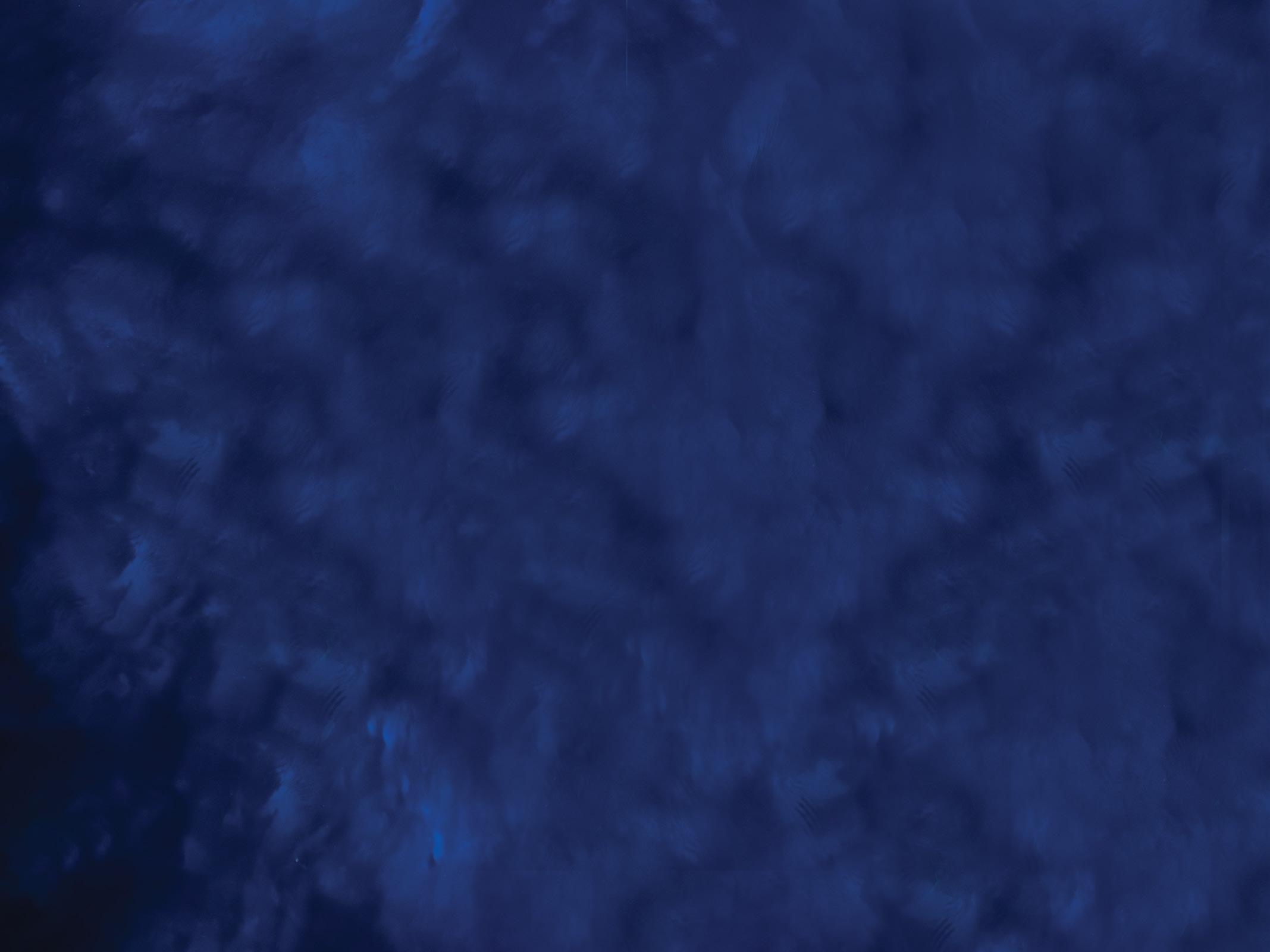

So, where do sharks fit in? Sitting at the top of the food chain, their existence underpins entire ecosystems.
Sharks prey on smaller predators. In open water, when sharks are removed, their prey overpopulate and reduce the numbers of smaller herbivorous fish, which in turn allows algae to become overgrown. In some circumstances, like a coral reef, this can cause total collapse.
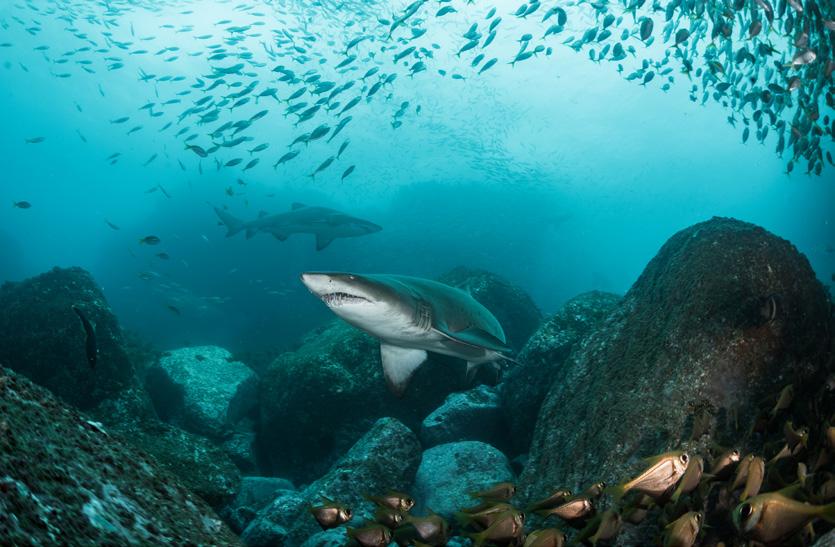
Meanwhile, in seagrass meadows, sharks preserve the habitats of crustaceans and small fish by controlling populations of turtles and dugongs that would overpopulate and overgraze seagrass if sharks were removed. When the seagrass is gone, the ecosystem is destroyed.
Seagrass and seaweed are also major carbon absorbers – the destruction of the ocean’s flora by unchecked populations of herbivores means more greenhouse gases in the atmosphere and a fast-track to global warming.
No species lives in isolation, including humans. Take out sharks and the balance of oceans falls down, as does the fishing industry, the containment of carbon in the water, the Jenga tower of life as we know it.
Prof Colin Simpfendorfer, James Cook University, QueenslandA challenge to learn more and act on what we know
The Australian Museum chose sharks as the topic of the 2022-23 blockbuster exhibition because they give us a clear example of our impact and opportunity in the natural world. As the apex predator for so many ecosystems, their removal will have dramatic consequences for life. Simply removing a top predator can turn rich areas into deserts. On the flip side, the measures needed to save sharks will help many more species and habitats. If we focus on sharks we can understand a global problem and imagine global solutions. This project was made possible thanks to Create NSW, NSW Department of Primary Industries, Lindblad Expeditions – National Geographic, Minderoo Foundation, Macquarie University and ABC Radio Sydney.
Sharks is showing at the Australian Museum throughout summer.All the things we have in our ecosystem are there for a reason.
For 450 million years, sharks have dominated Earth’s oceans. Today, their existence has never been under more threat. Our attitudes and our actions will decide their fate.
Sharks
Shark myths and facts
The largest fish that has ever lived was a shark
FACT
The Megalodon shark swam in our oceans between about 20 million and 3.6 million years ago. Scientists estimate that the Megalodon grew to 15–20m in length, which is three times longer than the largest recorded great white shark. These figures are based on their teeth, which could reach 18cm in length.
Shark DNA may hold the cure to cancer
FACT
University of Florida scientists have mapped the genome of the Great White Shark and noted that it reveals mutations which protect the animals against cancer and other illnesses. They hope to apply these findings to treat age-related illnesses in humans.
People have always disliked and feared sharks
MYTH
Many First Nations, Torres Strait Islander and Pasifika Peoples have beliefs and cultural practices around honouring sharks, and they are respected as being a vital part of the balance of the environment. In many Pacific Island cultures, sharks are admired for the very things that other people fear them for – their strength, speed and ferocity.
Sharks glow in the dark FACT
Moller’s Lanternshark – the third smallest known species of shark at 46cm is a bioluminescent, deep ocean shark. Having lights on its underside helps this little shark look like the water’s surface, making it hard for predators to spot it from below.
Sharks can smell blood in the water
FACT
A shark’s sensory toolbox includes an acute sense of smell, which works over long distances. Sharks can detect fish oil and injured prey up to several kilometres away.
Dinosaurs lived before sharks existed
MYTH
The first sharks evolved long before dinosaurs lived on land. But only some of the sharks cruising the world’s oceans more than 400 million years ago looked like sharks as we know them –most were very strange indeed.

But just how much do you know about these ancient survivors?
H a m m e rhe a d Sh a r k
Shark
chatterbox
Make
Sta r t with th e p ic ture sid e fa c e d own
1 . Fo l d dia g on a ll y a t c orn e rs a n d unfo l d 2 . Fo l d a ll c or ne rs to th e c e ntre
H a m m e rhe
Sta r t with th e p ic ture sid e fa c e d own
Sta r t with th e p ic ture sid e fa c e d own
elahW krahS
Play
1. C olour a nd fol d your sha rk chat terb ox.
2 . Hol d a nd move your chat terb ox with your thumbs forefingers under ea ch ta b.
ng e rs into th e 4 ta bs to fo r m 4 p oints
a d Sh a r k Make 1 . Fo l d dia g on a ll y a t c orn e rs a n d unfo l d 2 . Fo l d a ll c or ne rs to th e c e ntre 3. Tur n ove r a n d re p ea t s te p 2, fo l ding c or n e rs in 4 . Fo l d in h a lf ve r tic a ll y a n d h or izo nta ll y 5. Ins e r t 4 fi ng e rs into th e 4 ta bs to fo r m 4 p oints
3. Think of a fac t a b out sha rks. E xa mple, “Sha rks a r 4. S ay your sha rk fac t a nd move your chat terb ox as ea ch word. 5. Choose a fla p to op en. Lif t it a nd find your sha rk
k
How about colouring me in?
B u l l Sh a r k
DID YOU KNOW?
The Great White Shark has the ability to repair its own DNA so is far more tolerant to disease.
elahW krahS
Play
1. C olour a nd fol d your sha rk chat terb ox.
2 . Hol d a nd move your chat terb ox with your thumbs a nd forefingers under ea ch ta b.
3. Think of a fac t a b out sha rks. E xa mple, “Sha rks a re fish”.
4. S ay your sha rk fac t a nd move your chat terb ox as you say ea ch word.
5. Choose a fla p to op en. Lif t it a nd find your sha rk inside!
6. Follow s teps 3-5 to play a gain!
DID YOU KNOW?
Scientists can tell the age of a shark by counting the rings on their backbone.
What you can do to help save the sharks!
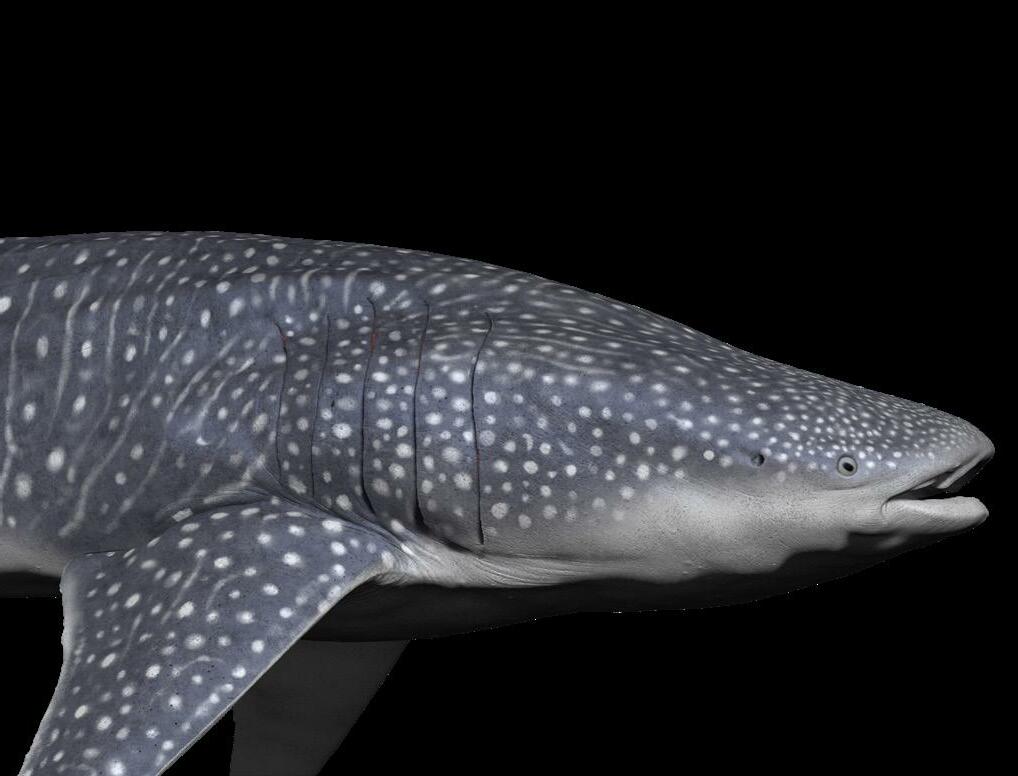
Better fishing
Support campaigns that promote better fishing practices.
Ban finning
Write to a local representative asking them to support a ban on shark fin trade in Australia.
Buy sustainable seafood
Buy seafood that has been sustainably sourced, including mussels, prawns and snapper. Find the full list at goodfish.org.au
Avoid
Don’t go to restaurants that sell shark fin soup or buy fish and chips that use shark meat (flake).
Local knowledge
Find out more about First Nations peoples’ local knowledge of the sea and relationship with sharks.
Deter sharks
Support your local beaches that use non-lethal shark deterrents like drones and SMART drumlines.
DID YOU KNOW?
On islands near Papua New Guinea, shark callers beckon sharks by using coconut shark rattles and catch them by hand.
The Coughran Crayfish Collection
Prof Shane Ahyong Senior Principal Research Scientist and Group Manager, Marine InvertebratesMost of us know yabbies (Cherax destructor), the hardy (and delicious) freshwater crayfishes that abound in inland rivers and farm dams throughout inland Australia. Lesser known are their cousins, the spiny freshwater crayfishes of the genus Euastacus that keep to themselves in cool, forested and sheltered bush creeks of eastern Queensland, New South Wales, Victoria and parts of South Australia. The 54 currently known species are endemic to Australia.
Spiny crayfishes are often vividly coloured and covered in spines. Their species have narrow geographic ranges, often living only in a single river or creek catchment. They grow slowly and require cool, high-quality water. Because of these characteristics, spiny crayfishes are highly susceptible to habitat destruction and climate change, making them a priority for conservation
efforts and further scientific research. During the 2019–2020 megafires that swept eastern Australia, many species of spiny crayfish had their geographic distribution burnt out.
In the early 2000s, ecologist and conservationist Dr Jason Coughran made important research collections of spiny crayfishes in northern NSW rainforests. The collection of about 100 lots, held at Southern Cross University, Lismore, was recently offered to the Australian Museum to ensure its longevity and to make it accessible to other researchers. In April 2022, our team was able to avoid the floods and retrieve the collection. Significantly, it contains many specimens from remote, very difficult-to-access rainforest localities. The specimens have detailed locality information and are suitably preserved for genetic analysis, making them valuable additions to the Australian Museum collections and important resources for further study and conservation work.
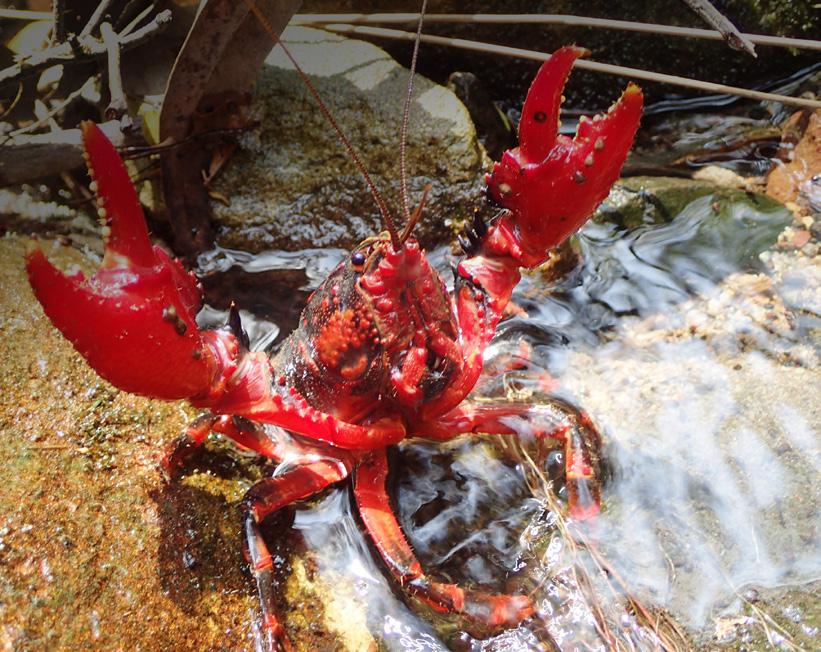
Tiny specimens
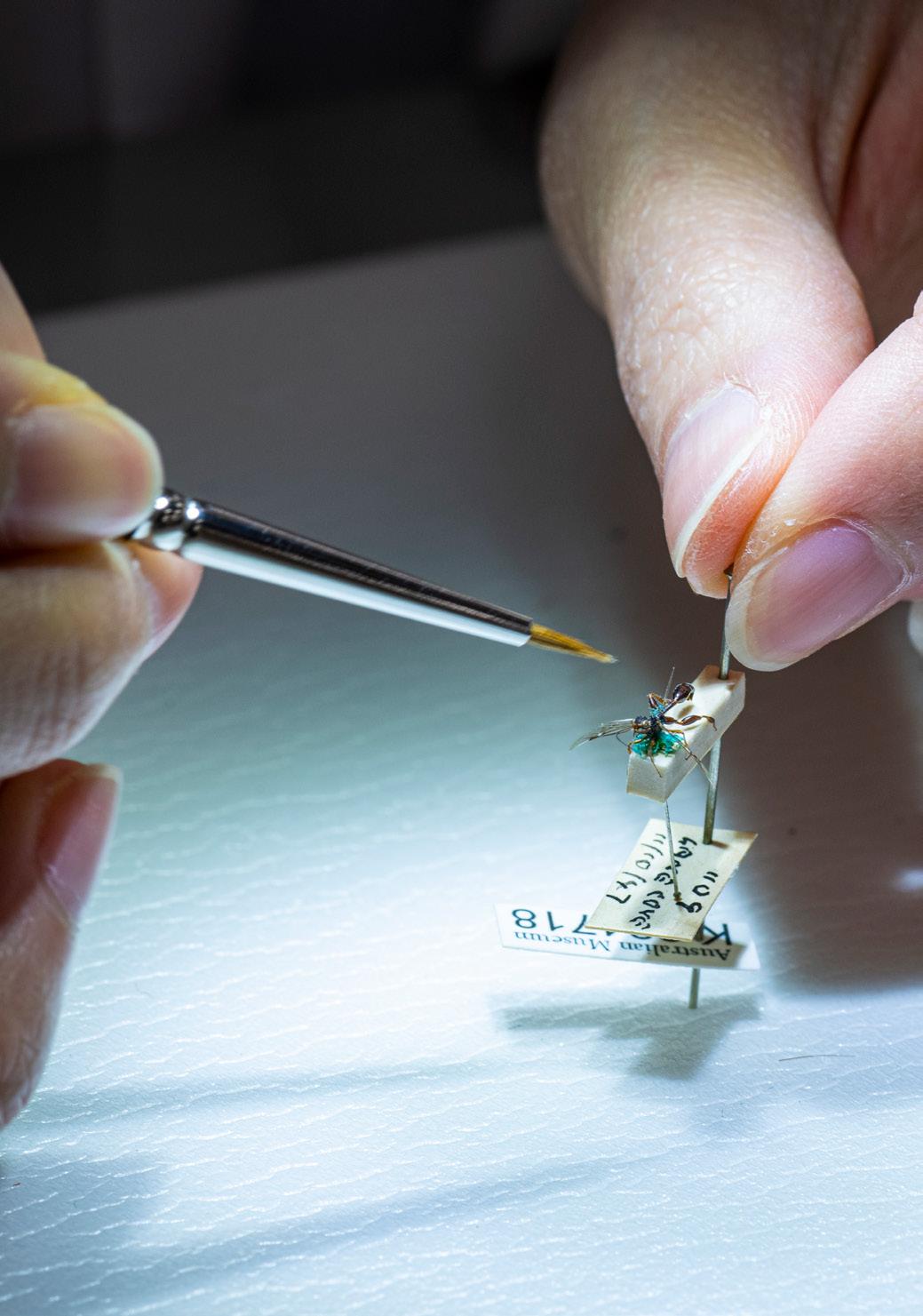
Think you have a steady hand?
Try cleaning the bristles of a 2mm-long fly.
Alice Gage, Editor, ExploreWhen she was hired, the Collection Care and Conservation team had no idea that their new conservator was an old hand at working with tiny things. In a previous life as a visual artist, Clare Kim created her works using a magnifying glass –miniature pencil drawings of morphing, textual shapes. Now in the lab at the Australian Museum, Clare once again brings her steady hand and lasersharp concentration to minute objects – this time, insect specimens under a microscope.
Clare is undertaking a special job as part of the Museum’s Collection Enhancement Project. Working closely with scientists in the Entomology Collection, Clare is assessing and treating the Museum’s tiniest specimens and preparing them to be photographed for their new digital record. Three years into the project and Clare has examined hundreds of entomology specimens, often just millimetres long, to discern whether they need treatment or if they can be stabilised without excessive intervention.
“There are different reasons as to why we’d be assessing a specimen,” Clare says.
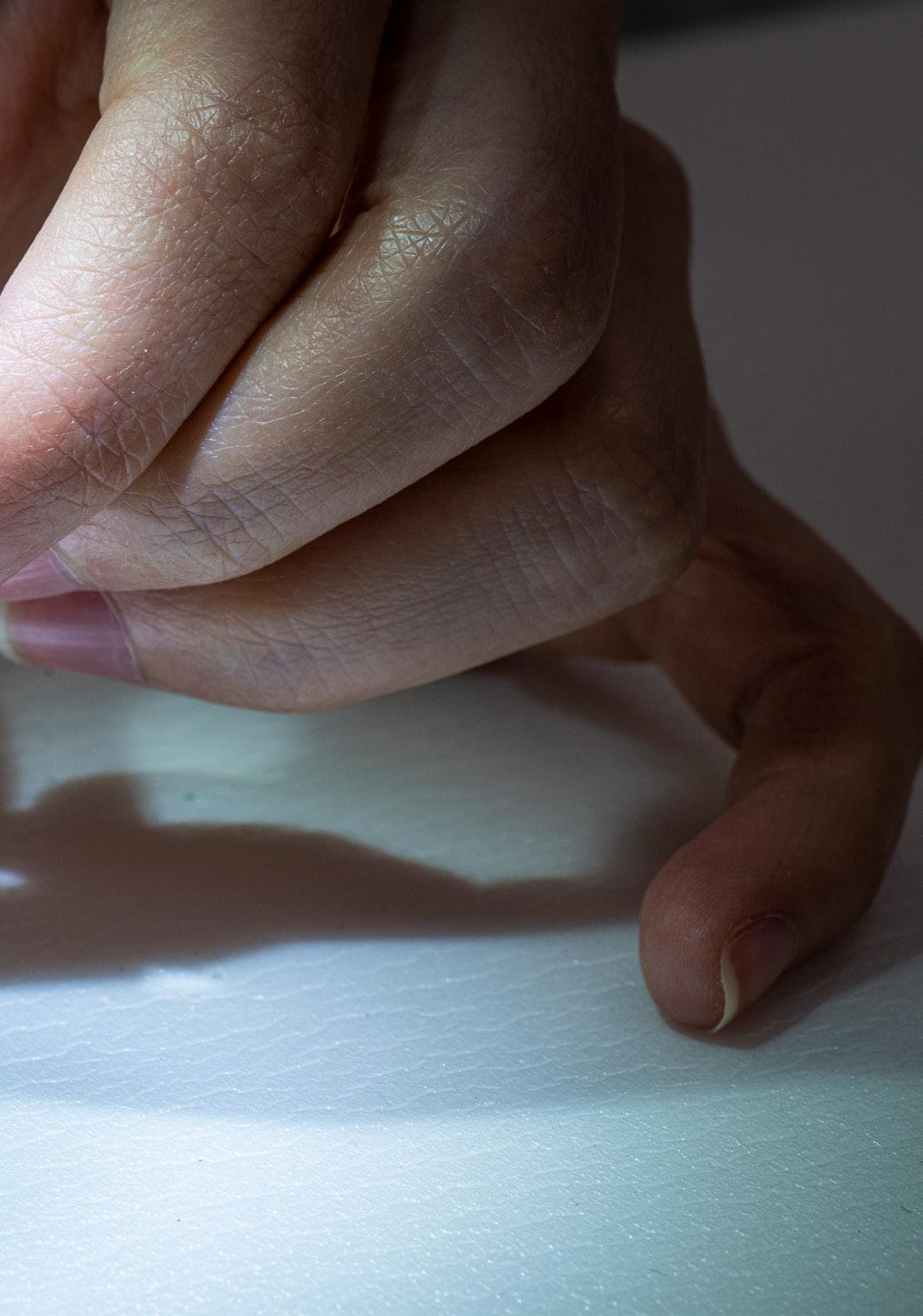
“Some are type specimens (the highly valuable specimens used to describe a new species) and require detailed documentation and photography. And some are fragile specimens at risk of being damaged or destroyed by corrosive acids or fungal growth.”
“We assess the specimens first to ascertain whether or not they need treatment. Treatment comes with risks. So, if a beetle has lost a leg, for example, but scientists can still study it in parts, the beetle and its leg can simply be safely re-mounted. We will avoid undertaking further intervention if we can.”
The accumulation of verdigris on some specimens is a primary problem. Verdigris is the blue-green substance that seeps out of metal alloys. In museum specimens, a reaction can take place between an old pin that fastens an insect to its label, and the fats and oils from the specimen itself. The result is verdigris and, if left untreated, it can build up and break the fragile creature into pieces.
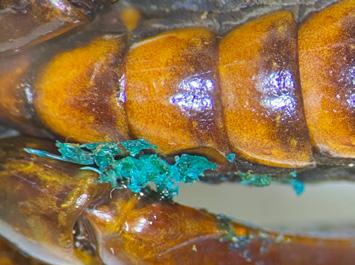
“We remove the pin. Then we clean the verdigris off the specimen and insert a replacement pin made from stainless steel, or use a conservation-grade adhesive to stick it to a card, if that’s what the entomology team prefers. Every specimen is different!”
Fungal growth is another big problem for these little bugs – spores can become active and destroy the specimen. Any fungal growth must be cleaned off.
“This is very satisfying,” says Clare with a laugh. “It’s like I’m giving them a shower.”
Australian Museum entomologist Dr Shane McEvey is clearly appreciative of Clare’s skill and patience.
“Clare has been tasked with repairing insects in “the hospital drawer,” he says, referring to the specimens that have been damaged while on loan to other institutions for study, or have been identified as being in danger of degradation.
“Cleaning and rearticulating minute animals comes with risks. In flies, the bristles are very important, as they’re often the feature that is used to identify a species. Thinner than a human hair,
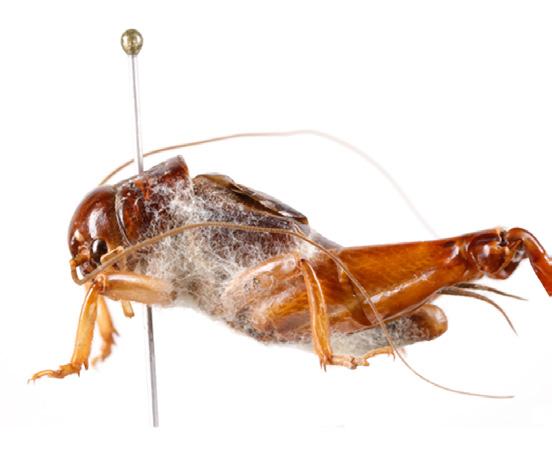
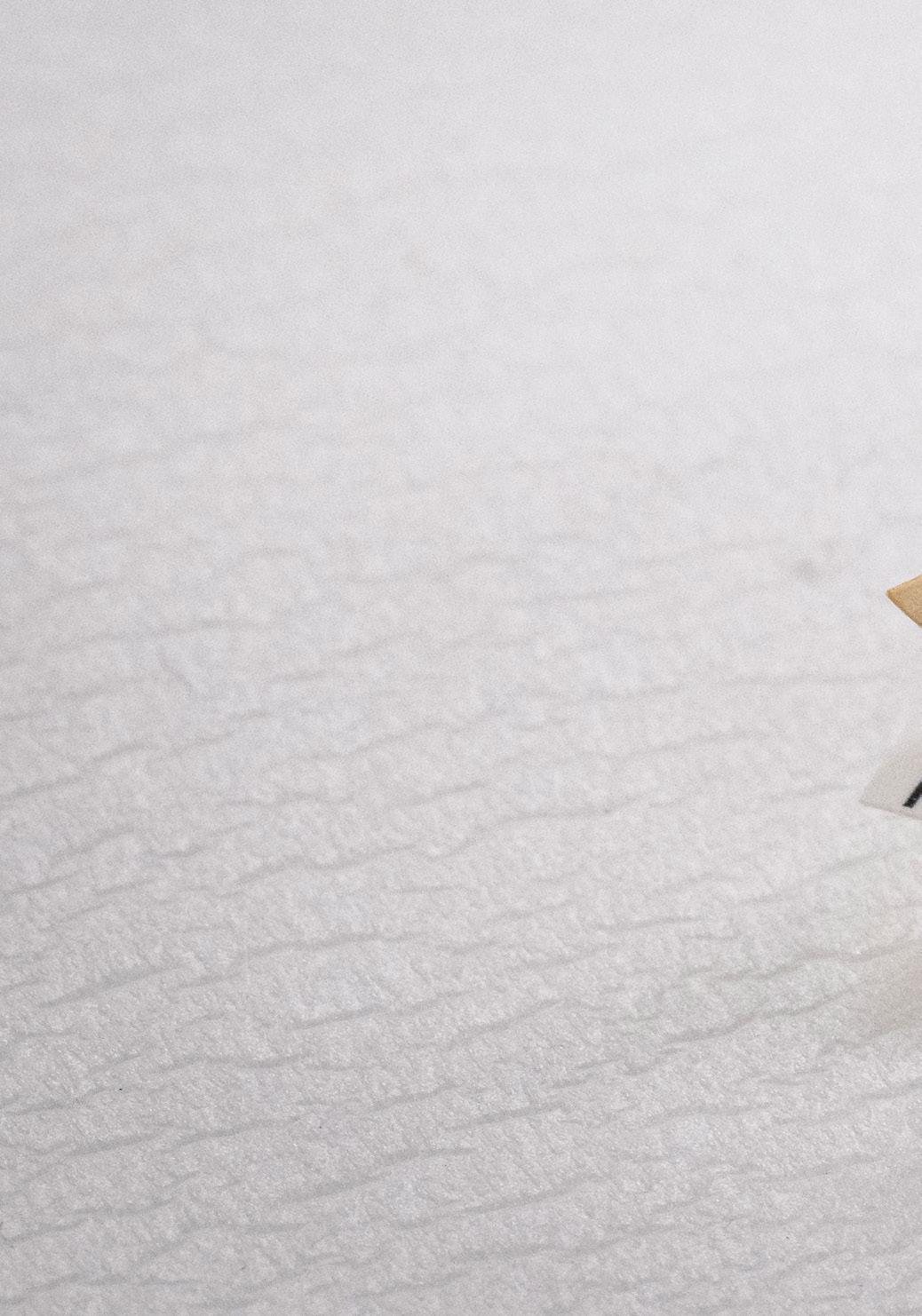
bristles are incredibly fragile. The work must be done under a microscope, and with extraordinary care and skill,” he says.
When Clare has finished her work, she will photograph the newly cleaned and mounted insect from all angles. A technical officer will transcribe its label – sometimes hand-written a hundred years ago when the specimen was collected – and together this data will create a digital record that will last forever. In this way, scientists all over the world can continue to study the amazing biodiversity of our planet, far into the future.
Entomologist Russell Cox sees Clare’s careful work as an artform in itself. “Watching Clare restore a centuryold specimen brings to mind an artist reconditioning a Rembrandt painting; these are the same skills and expertise she uses to breathe life back into a diminished butterfly,” he says.
Above, left and previous page: Conservator Clare Kim at work in the lab at the Australian Museum. Photo by Abram Powell
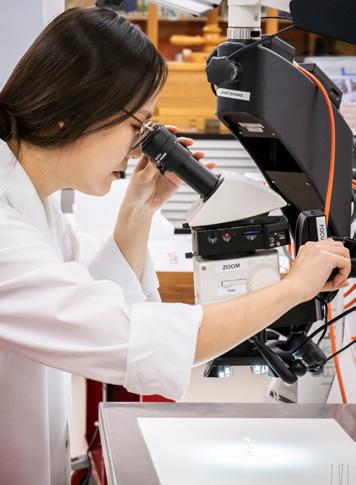
Below: Before and after cleaning of a Rainforest Burrowing Cricket ( Cephalogryllus tau) specimen. Photo by Clare Kim and Natalie Tees
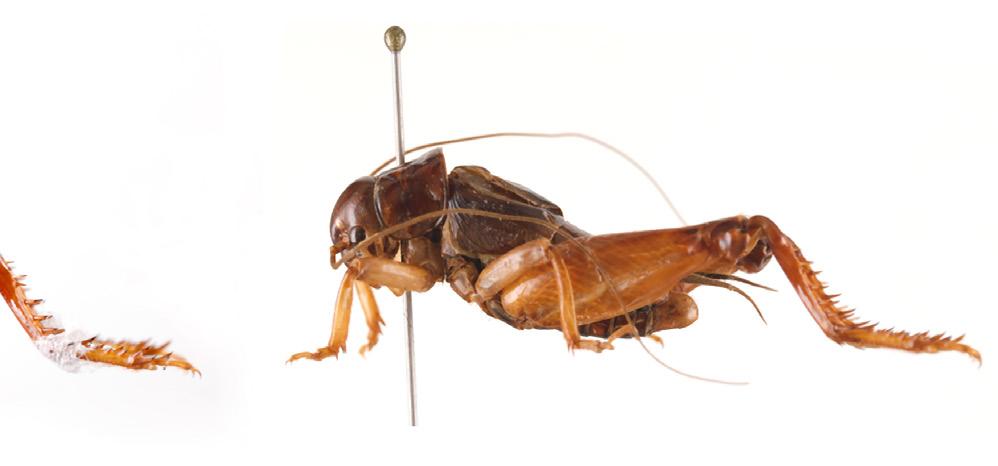
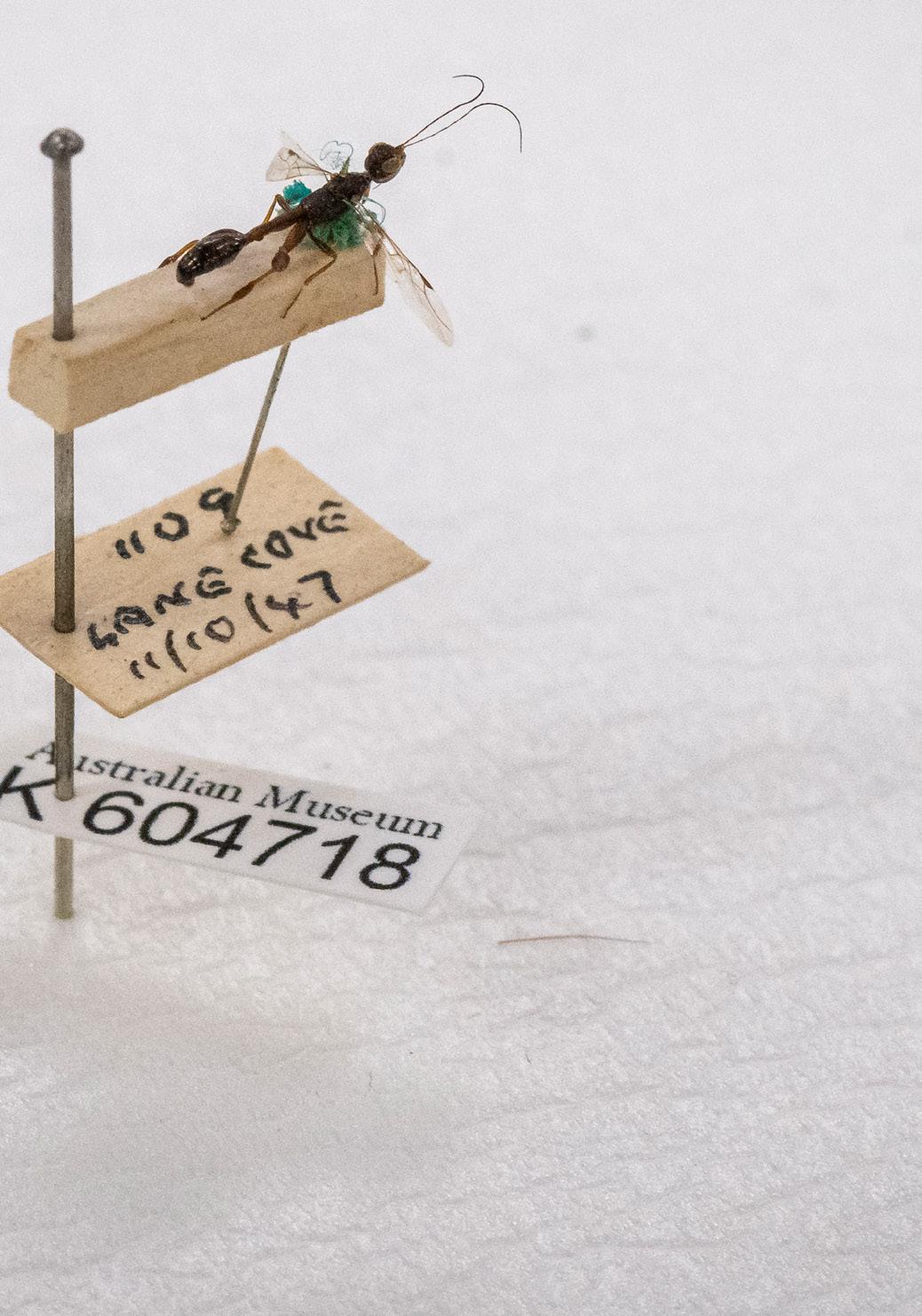
Watching Clare restore a century-old specimen brings to mind an artist reconditioning a Rembrandt painting
The
spectacular, ancient crystals of the
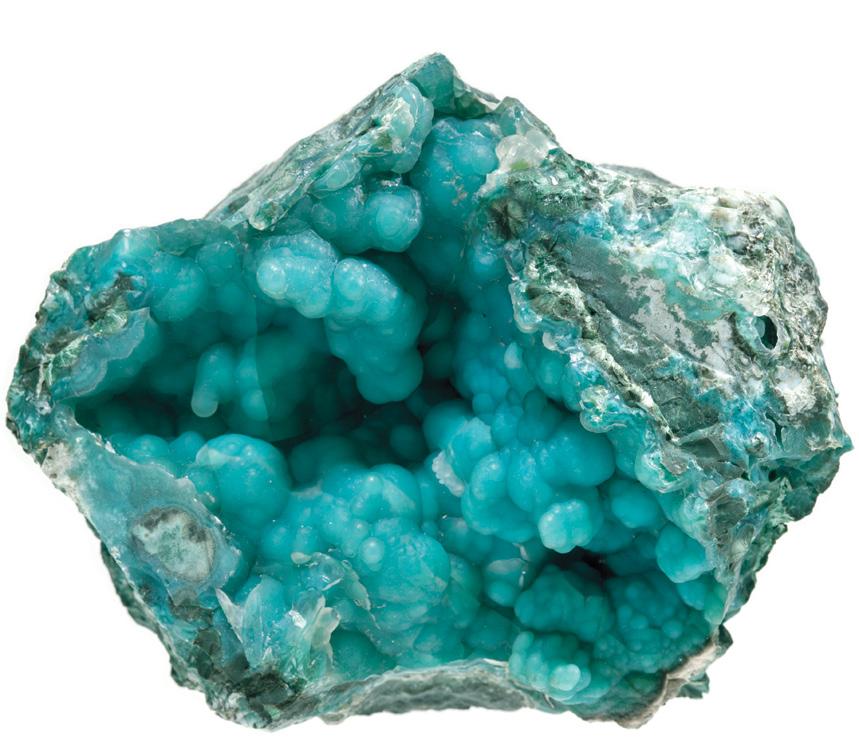
MINERALS GALLERY
Ross Pogson Collection Manager, MineralogyThree years in the making, the Australian Museum’s new Minerals gallery is now open.
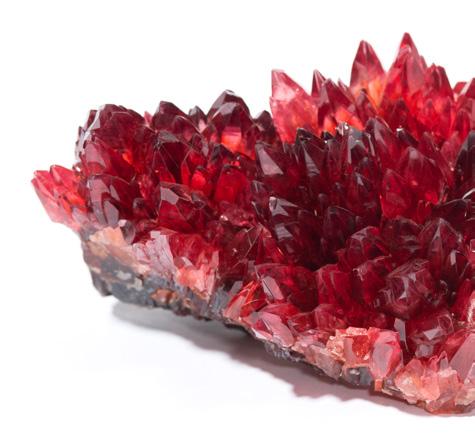
Above: Rhodochrosite, N’chwaning Mine, Northern Cape Province, South Africa. 7.6 x 14.1 x 5.2 cm. Albert Chapman Collection Opposite: Chalcedony with chrysocolla, Arizona, USA. 9.5 x 12.5 x 6.2 cm. Albert Chapman Collection
Since its inception in 1827, the Australian Museum has collected Australian and international minerals, rocks, meteorites and tektites, considering them an integral part of its natural history collections.
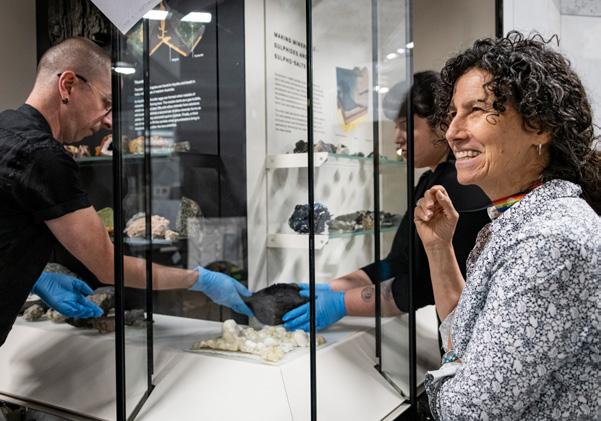
A mineral is a naturally occurring, normally crystalline and homogeneous solid chemical substance produced by geological processes. But that’s where the science-speak ends – you don’t have to be a trained mineralogist to appreciate their rarity, perfection, fragility, beauty, colours, shapes and symmetry. When all of these properties come together we have something very special, a masterpiece which can take pride of place in a museum collection.
The best of these specimens are like old master paintings. In fact, you can think of them as the Rembrandts of the mineral world. They are irreplaceable parts of our natural history, saved for posterity. These specimens are the only record of the unique chemical conditions which made them at a particular time and place, and can never be obtained again.
Rocks and minerals are all around us, some immediately visible, others needing extraction from a mine to expose them. In the 19th century, when copper, tin, lead, zinc and gold were found in Australia, mines proliferated. In those days, mining methods were gentle, usually involving
Right: Sheldon Teare and Sophie Phillips (Collection Care and Conservation) and Dayna McGeeney (Mineralogy Collection) install minerals into the cabinets while Prep staff put the finishing touches on the gallery space. Photo by Abram Powell
limited use of explosives and a lot of pick and shovel work. This meant among the ores, many beautiful crystallised mineral specimens were recovered. Miners often kept these crystals or sold them. This led to interest from museums and private collectors. Museum staff visited mines and became acquainted with private collectors to acquire specimens. The experts were particularly interested in mineral species new to science because of their different chemical compositions and crystal structures. This continues today – there are currently 5828 approved mineral species as of 2022, with more being added every year.
Some of the finest specimens of the Australian Museum’s collection were donated or bought from private collectors. They bear famous names such as George Smith, Albert Chapman, Sir Douglas Mawson and Prof Warren Somerville AM, and the specimens themselves often have their own fascinating histories. For these collectors, assembling a fine mineral collection was a lifelong passion and we love to share their prized treasures with our visitors.
As you admire our wonderful treasures from the mineral kingdom, note their contrasting colours, crystal shapes, symmetry and exotic origins. They have stories of their own to tell and have survived millions of years for you to enjoy them.
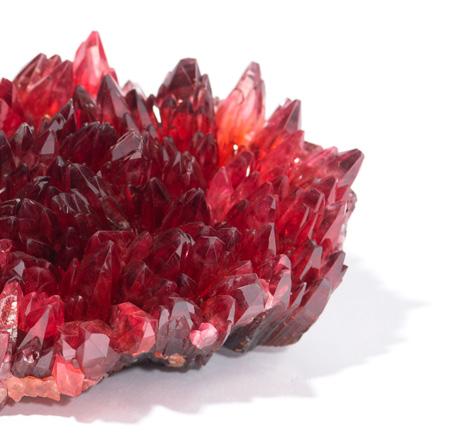
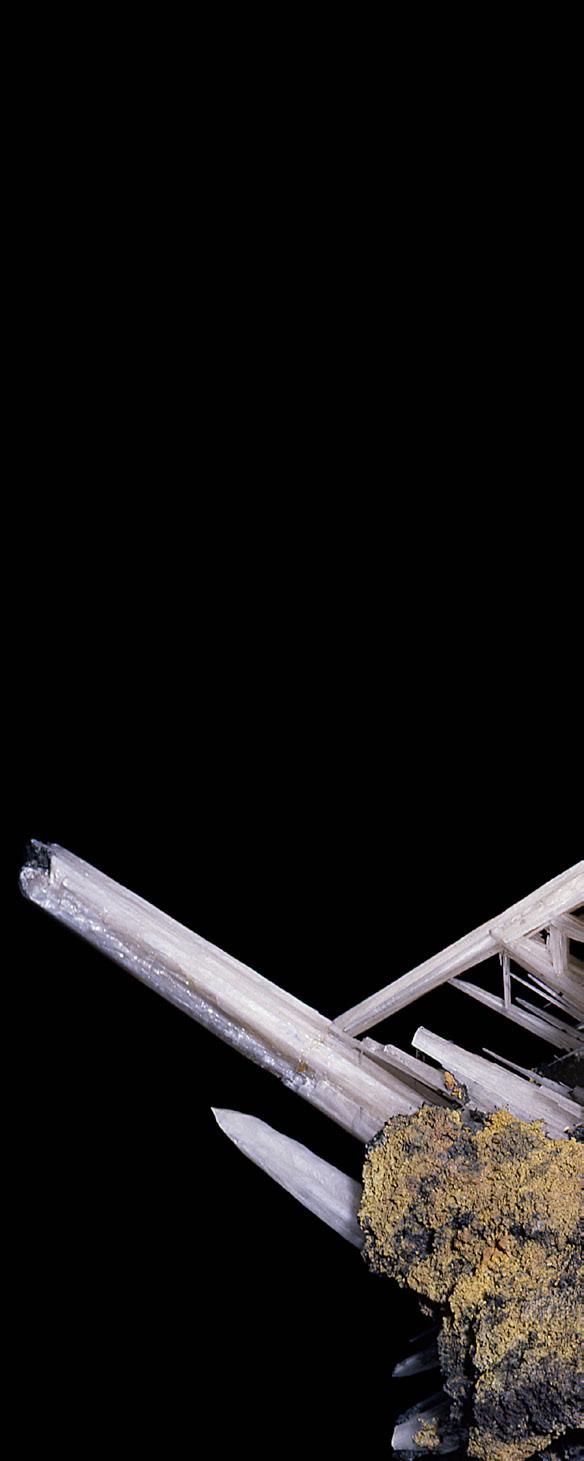
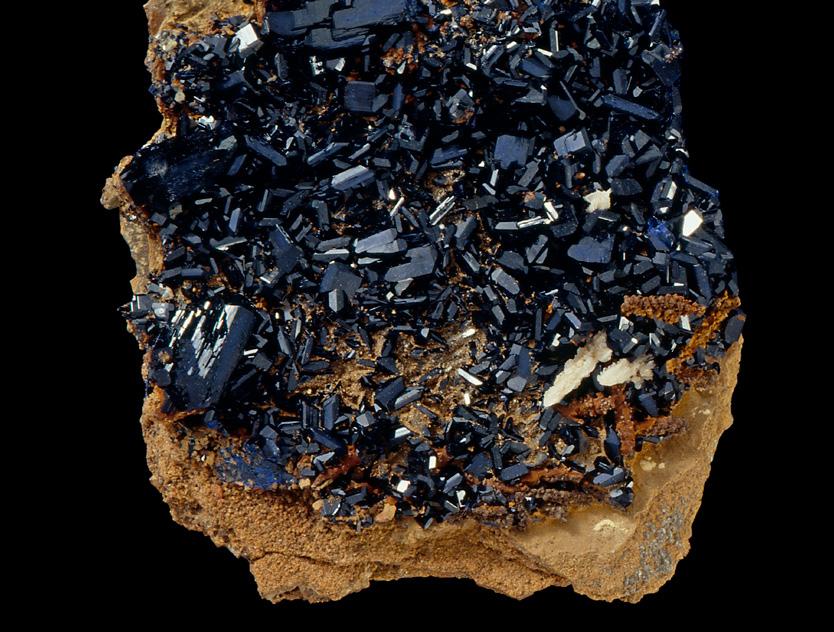
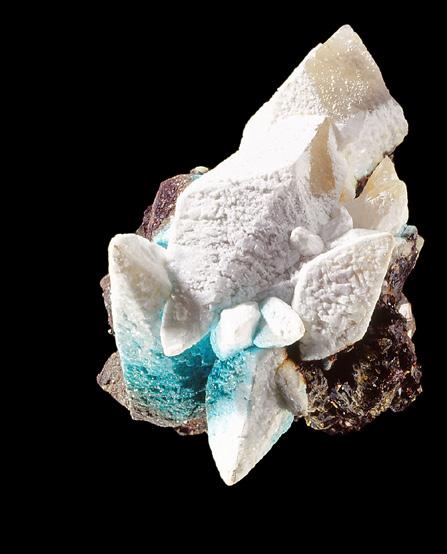
Clockwise from above:
Azurite with malachite and quartz, Mount Hope, NSW. 8 x 3.5 x 3.3 cm.
Albert Chapman Collection
Cerussite, BHP Block 14 Mine, Broken Hill, NSW. 33 x 27 x 12 cm
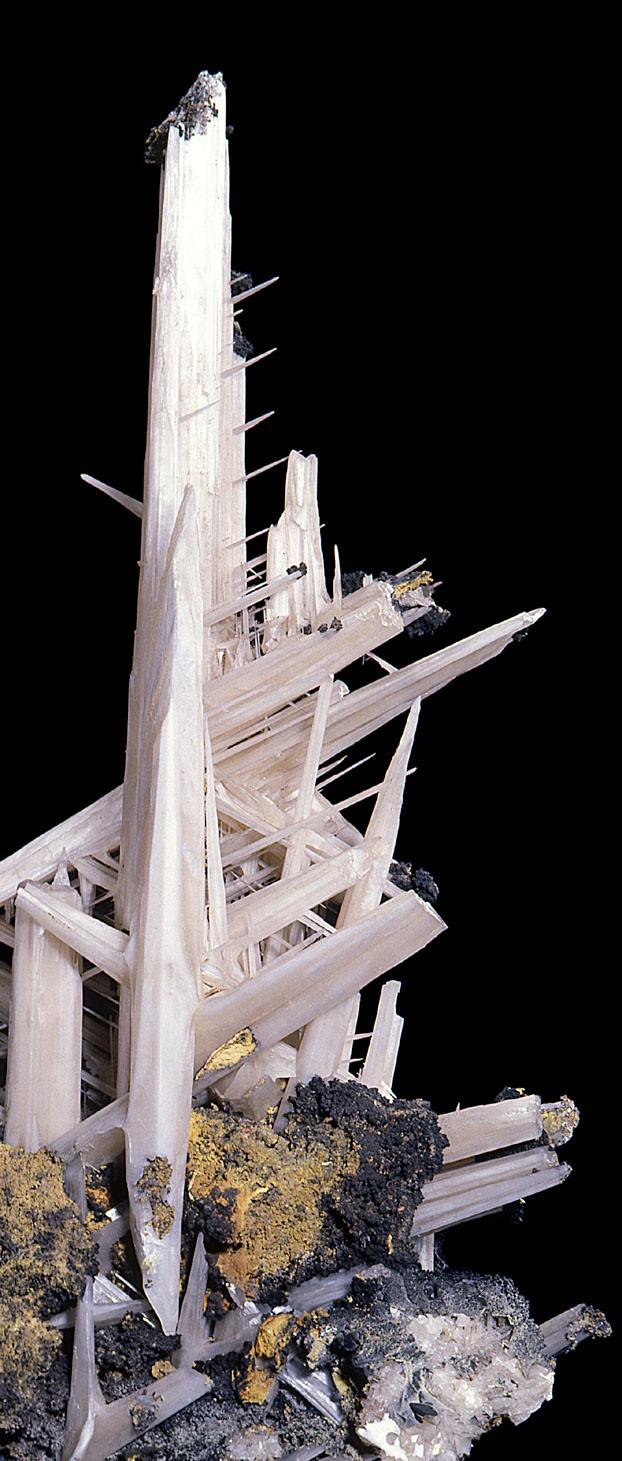
Calcite, Treece, Kansas, USA. 12 x 10 x 9.7 cm
Azurite with Cerussite, Proprietary Mine, Broken Hill, NSW. 12 x 12 x 5 cm.
Albert Chapman Collection
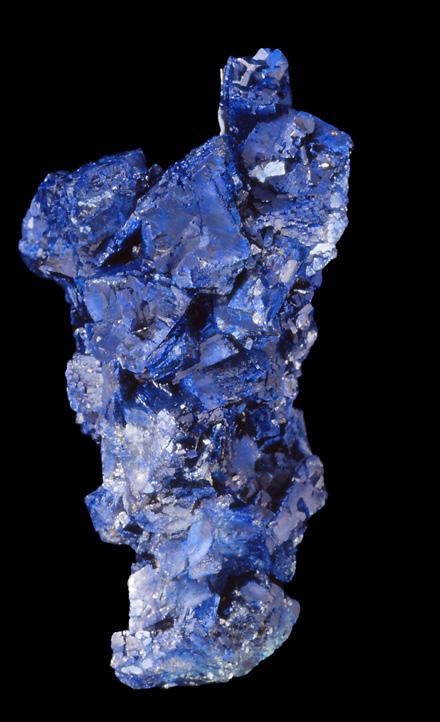
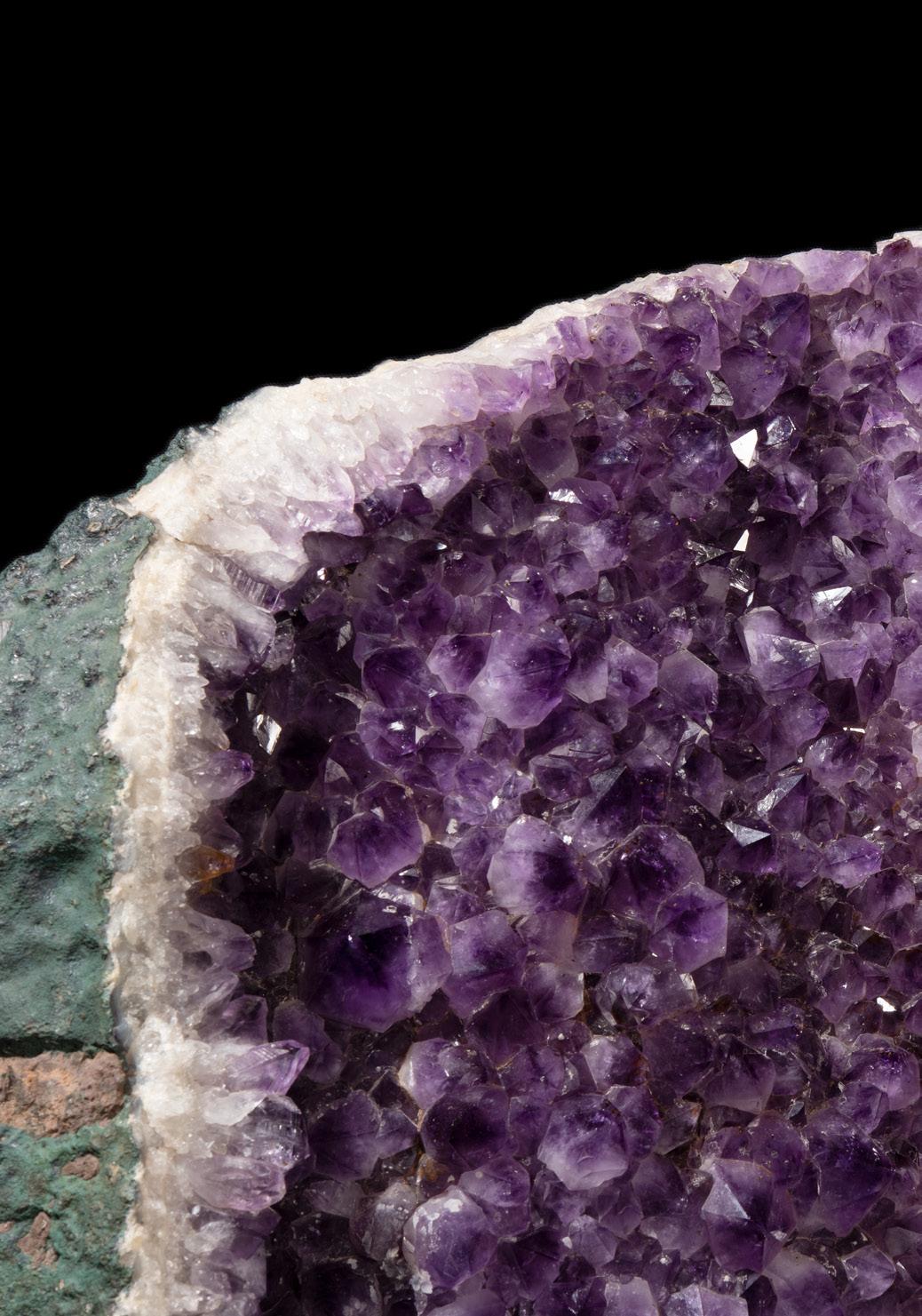
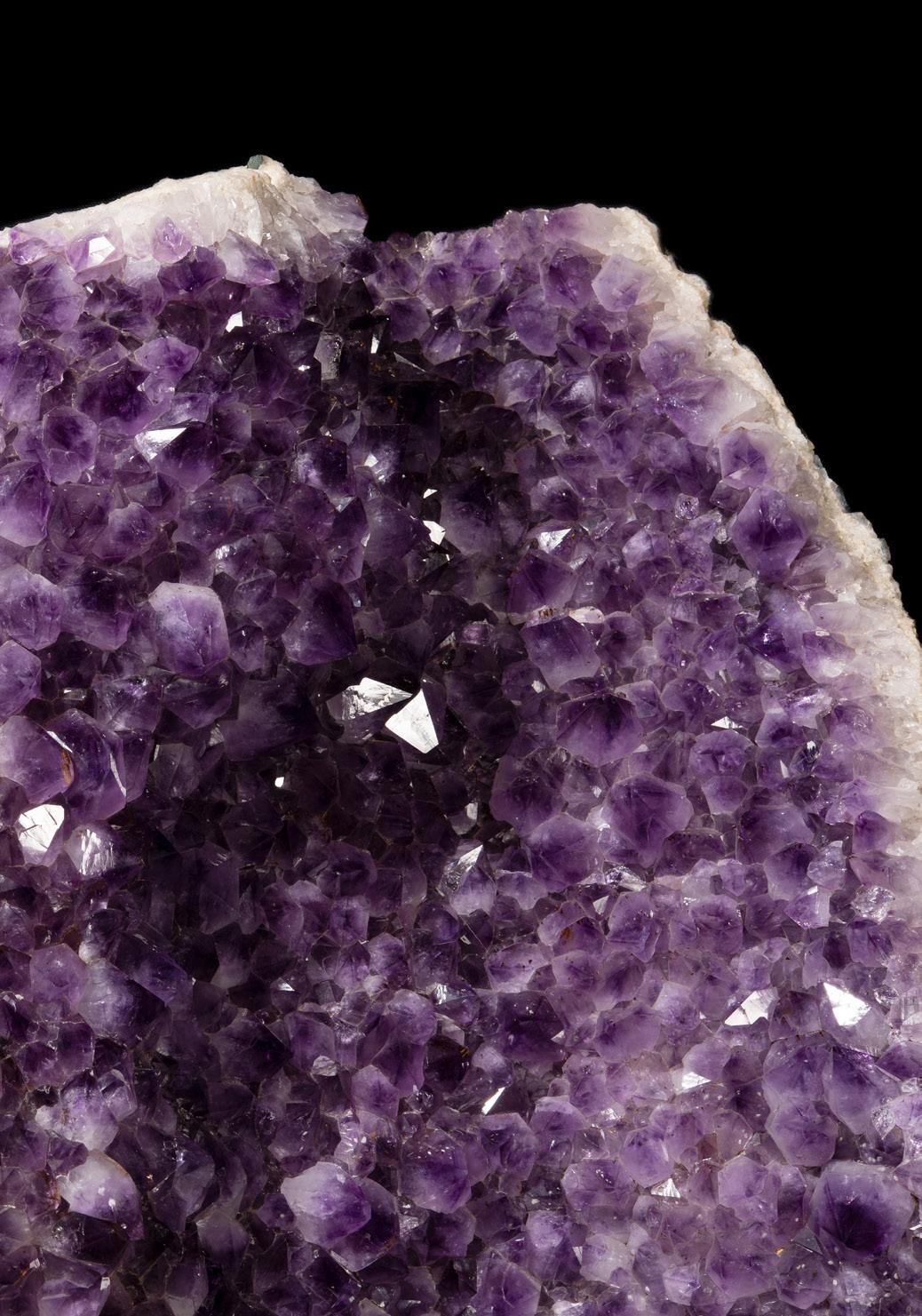
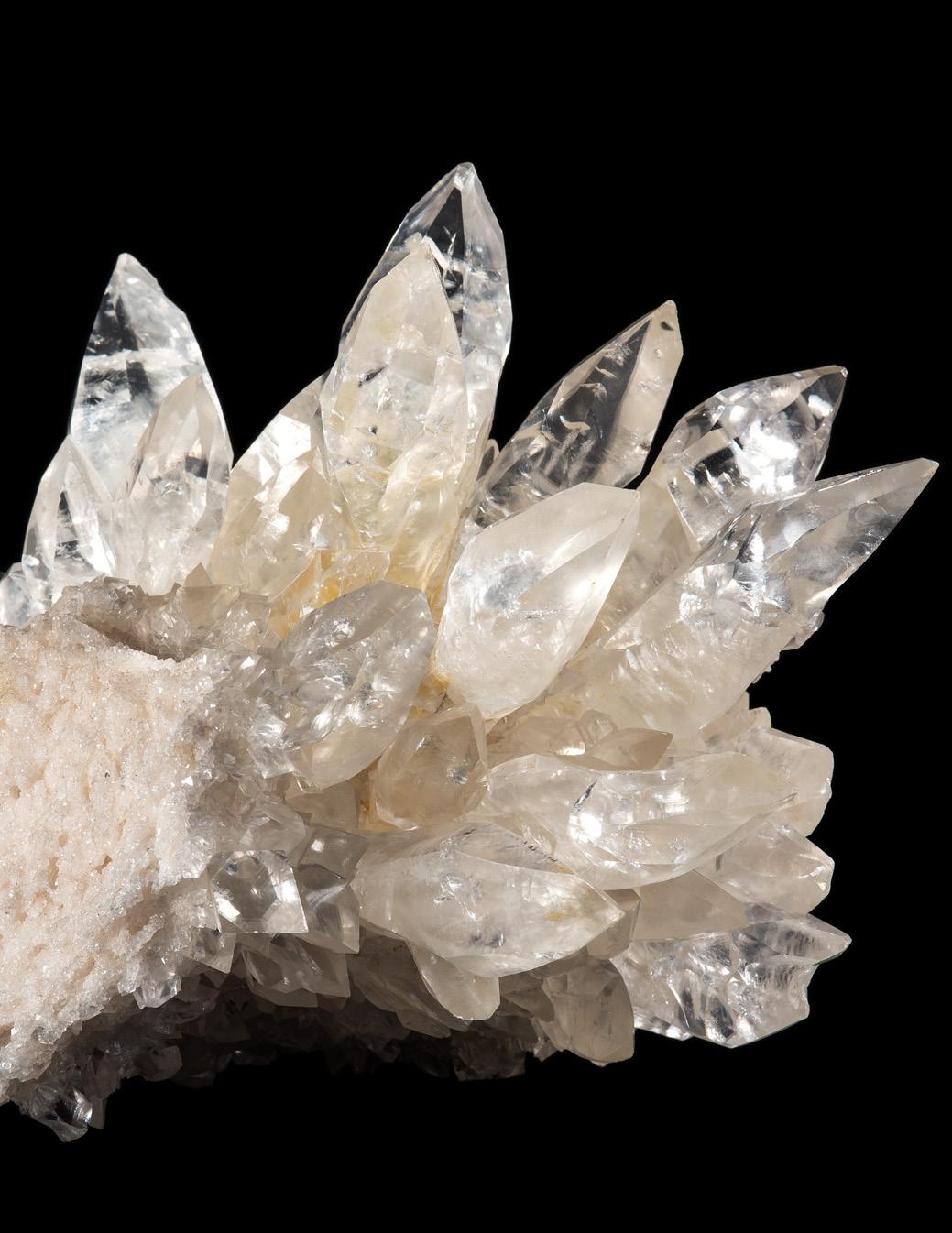
Opposite: Calcite Crystals, Cliefden Caves, Carcoar, NSW. 20 x 15 x 10 cm
Below clockwise from top left: Opal (gastropod), Coober Pedy, SA. 2.2 x 1 x 1.4 cm. Albert Chapman
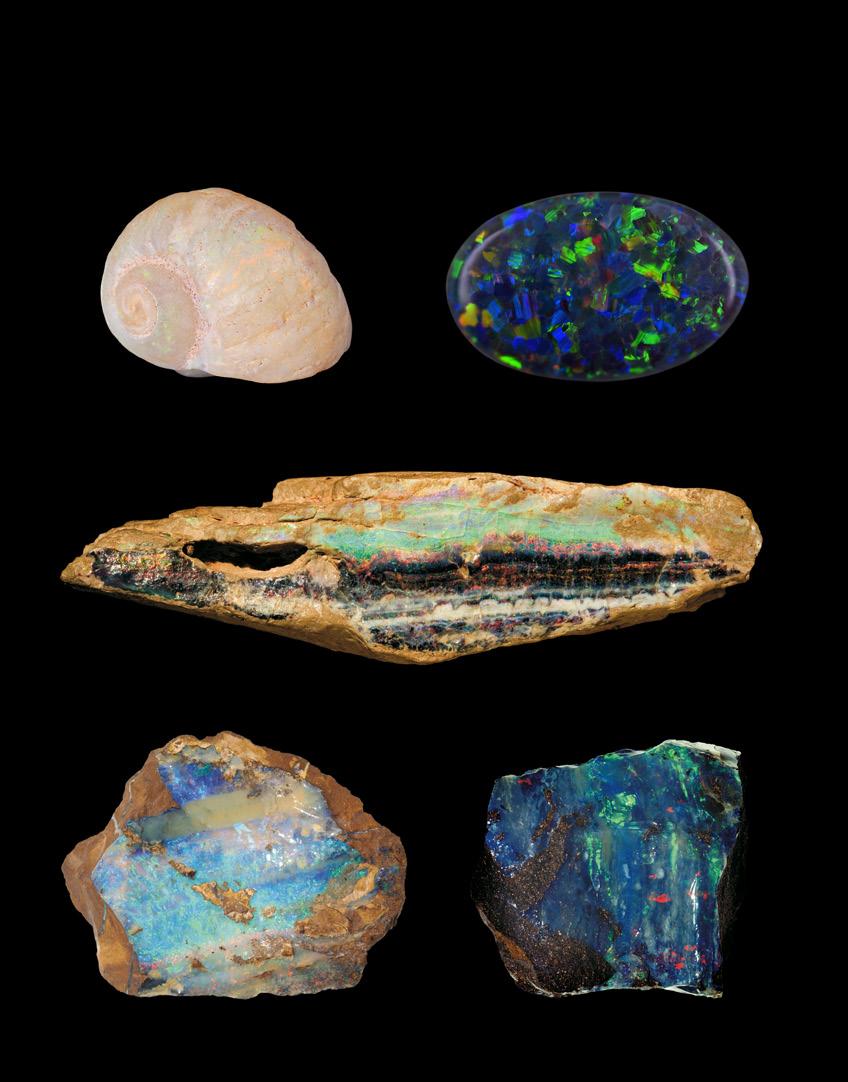
Collection
Black opal, Lightning Ridge, NSW. 1.68 x 1.07 x 0.44 cm, 4.8 ct
“Painted Lady” opal on quartzite, White Dam, Andamooka, SA. 43.5 x 33.5 x 10.8 cm
Boulder opal, Quilpie, QLD. 4 x 4 x 3.6 cm. Albert Chapman Collection Boulder opal, QLD. 7.6 x 6.2 x 3 cm. George Smith Collection
Ross Pogson
Collection Manager, Mineralogy
I always knew what I wanted to do, and my early interests and hobbies all centred around rocks and minerals. I can trace my geological interest back to a family holiday at Thirroul, New South Wales, when aged about four years I was fascinated by the smooth stones on the beach. This progressed to collecting minerals in volcanic “blue metal” gravel covering my primary school playground (I still have those specimens). Throughout high school I was collecting, buying and swapping minerals, and I learnt to recognise many hundreds of species by sight alone, together with their properties and localities. I read extensively, absorbing classic mineralogy books which were normally university texts. One book I treasured was Australian Rocks, Minerals and Gemstones by Robert Oliver Chalmers, Curator of Minerals at the Australian Museum. Little did I know at the time that I would later work at the AM and get to know Oliver as a friend and colleague.
I went on to study at the University of Technology, Sydney, where I fine-tuned my knowledge and experience thanks to dedicated lecturers. I undertook an Honours project making my own electrical prospecting equipment and conducting
electrical surveys over a small lead sulphide deposit near Goulburn, combining my interests in geology and electronics. I also developed an affinity with computers and wrote programs to solve complex geological calculations in three different computer languages, a skill used extensively at the AM doing research on volcanic rocks. I managed to diversify my studies, which later came in handy at the AM –I did two semesters of biology, which helped me to understand the work of my museum colleagues. Being very good with a microscope also helped me get a job at the Museum – my parents had given me my first microscope when I was eight.
This is now my 43rd year of working at the Australian Museum. I started at the AM in January 1979, hired initially to reorganise the rock collection. My AM career progressed through a series of promotions and increased responsibilities, leading to Senior Technical Officer, then Scientific Officer, Mineralogy Collection Manager and Group Manager, Geosciences and Archaeology. Today at the AM
I manage a collection of over 60,000 minerals and 20,000 rocks. I have extensive knowledge of these collections and remember many individual specimens – their histories and what they look like.
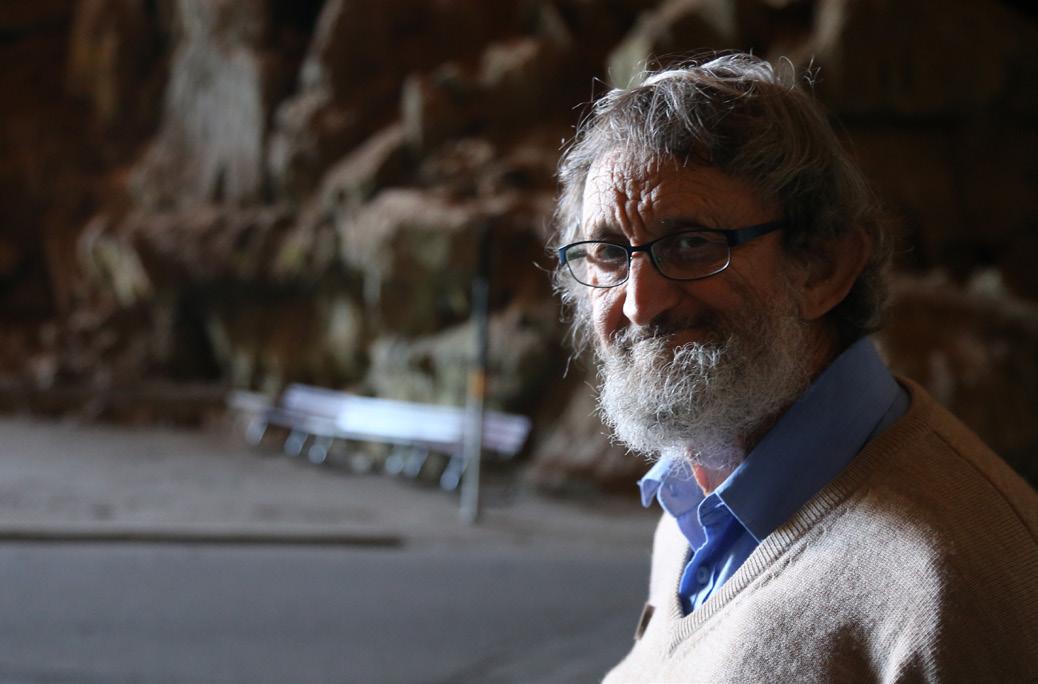
I became intensely interested in the meteorites, thanks to previous Curator of Minerals Oliver Chalmers, who taught me a lot about this subject.
The mineral collection has many silicate minerals known as zeolites, which grow in volcanic rocks. There was a problem with identifying these as many look similar and the usual tests were timeconsuming. So, I went back to university to study a new cutting-edge method called laser Raman spectroscopy, which I hoped would help the identification task. My work was successful and led to the awarding of a MSc.
For the past 30 years, my main research project has been a study of minerals at Jenolan Caves, which I first visited as an 8 year old. The caves always held a particular fascination for me so it was a delight to do work there with Armstrong Osborne from Sydney University and AM Research Associate David Colchester. Our work led to the identification of 15 mineral species previously unknown from Jenolan, and a much older date of formation for the caves.
I enjoy being a mentor to students of geology and anyone with a geological curiosity. I take every opportunity to participate in AM public programs
Above: Ross Pogson displaying specimens in the Long Gallery, 1982. Photo by Kate Lowe
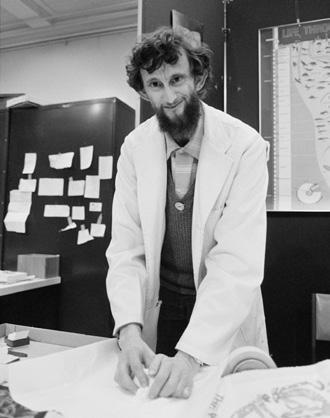
Left: Ross Pogson, aged 4, taken by his uncle, 1955. Photo courtesy of Ross Pogson
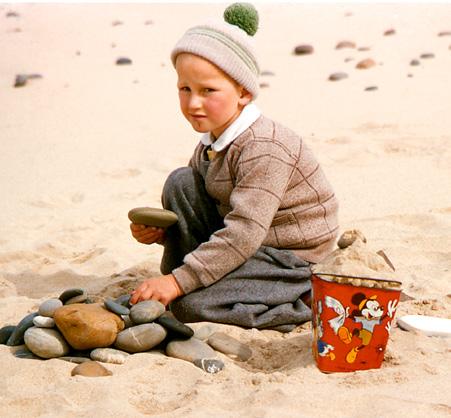
Opposite: Ross Pogson at Jenolan Caves, 2016. Photo by Ellie Downing
such as the Sydney Science Trail and of course exhibitions, sharing my passion and enthusiasm for minerals. I was a member of project teams for the Planet of Minerals gallery which opened in 1986, the Albert Chapman Collection in 1996, the Chapman mineral display at the Australian Fossil and Mineral Museum, Bathurst, in 2019 and the new Minerals gallery, which has just opened. I very much enjoyed writing and selecting the highlighted minerals for the gallery catalogue, which you can see an extract of in this issue of Explore
My interests have led to membership of nine scientific societies covering geology, mineralogy, cave studies and astronomy. I have been Vice President, Secretary, Education Officer and Librarian of the Mineralogical Society of NSW. I have contributed to over 60 papers in scientific journals and conference abstract volumes on such diverse topics as mineralogy, meteoritics, petrology, laser Raman spectroscopy, medical technology, palaeontology and archaeology. My contributions to AM collection management and research were recognised with the awarding of the Australian Museum Research Institute Medal in 2020.
I can trace my geological interest back to a family holiday at Thirroul, when aged about four years I was fascinated by the smooth stones on the beach.
One person’s roadkill is another’s scientific treasure
Dane Trembath Technical Officer, Herpetology CollectionThroughout the year, the Australian Museum receives generous donations of biological specimens from a range of donors. These specimens help to grow and supplement the already existing natural science collections. Donors range from government departments and universities to members of the general public. The majority of these specimens are found dead as roadkill. With the growth in social media, a lot of these events are now being captured and shared to promote safety for animals and drivers when on the road. It’s within these forums that there appears to be a growing number of people calling for rare and interesting roadkill to be documented in the
Australian Museum collections. We are very grateful for the help of these citizen scientists, as our small staff simply cannot be everywhere to record Australia’s biodiversity and its changes over time.
This year the Australian Museum Herpetology Department travelled nine hours to the Border Ranges, on the New South Wales and Queensland border, to collect a specimen of the threatened Stephen’s Banded Snake ( Hoplocephalus stephensii ) that had been hit by a car and died. Thanks to a local naturalist who recognised that the snake was unusual, the specimen was collected and kept frozen until our scientists could retrieve it.
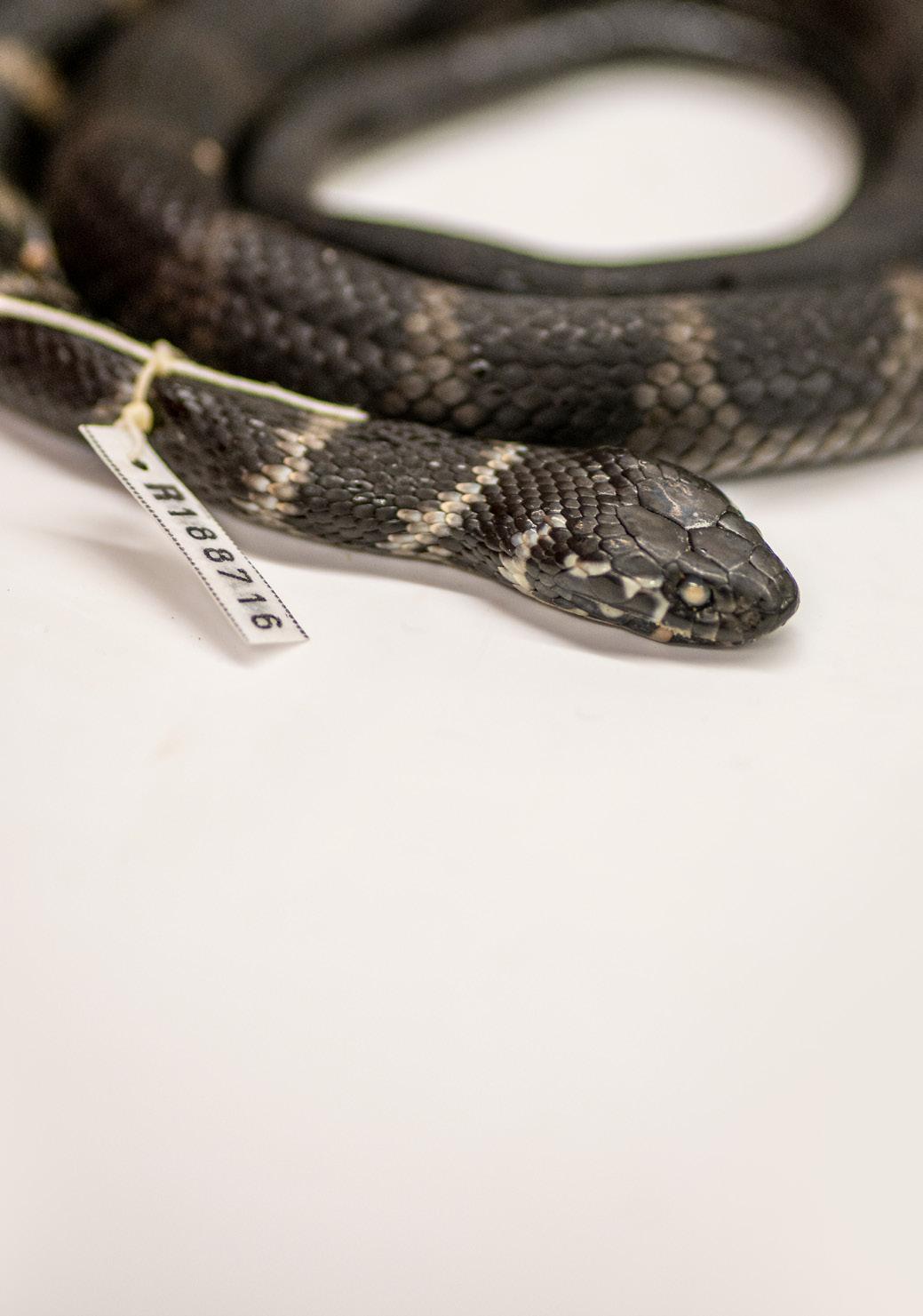
Above: The Stephen’s Banded Snake ( Hoplocephalus stephensii ) specimen retrieved from the Border Ranges, acquired 2022. Photo by Abram Powell
Right: “Heads of Australian Snakes (Venomous)”, featuring Stephen’s Banded Snake (fig 7) from Gerard Krefft’s Snakes of Australia, 1869. Australian Museum Archives
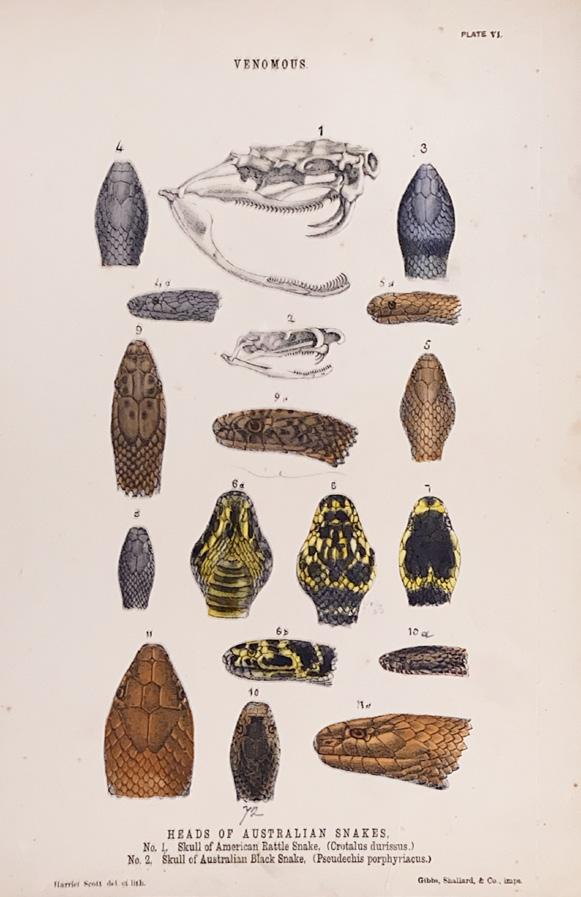
This species is an inhabitant of coastal forests in NSW and Queensland, where it faces the threat of continued habitat loss and may also have been affected by the 2019-20 Black Summer bushfires. Due to its secretive nature and habitat specificity, the Museum does not have many specimens or associated tissues from this species that could be used for genetic studies, so we were very pleased to add it to the collection.
This species was described by the Museum’s first curator Gerard Krefft in 1869 in his book Snakes of Australia: An Illustrated and Descriptive Catalogue of All the Known Species. When a species is first
described the description is based on an original specimen, which in turn is deemed the “holotype”. The Australian Museum still holds the original Stephen’s Banded Snake that Gerard Krefft examined over 150 years ago.
The Australian Museum Herpetology Department takes pride in retrieving and preparing these specimens for the collection as each roadkill is an important scientific observation that is otherwise lost.
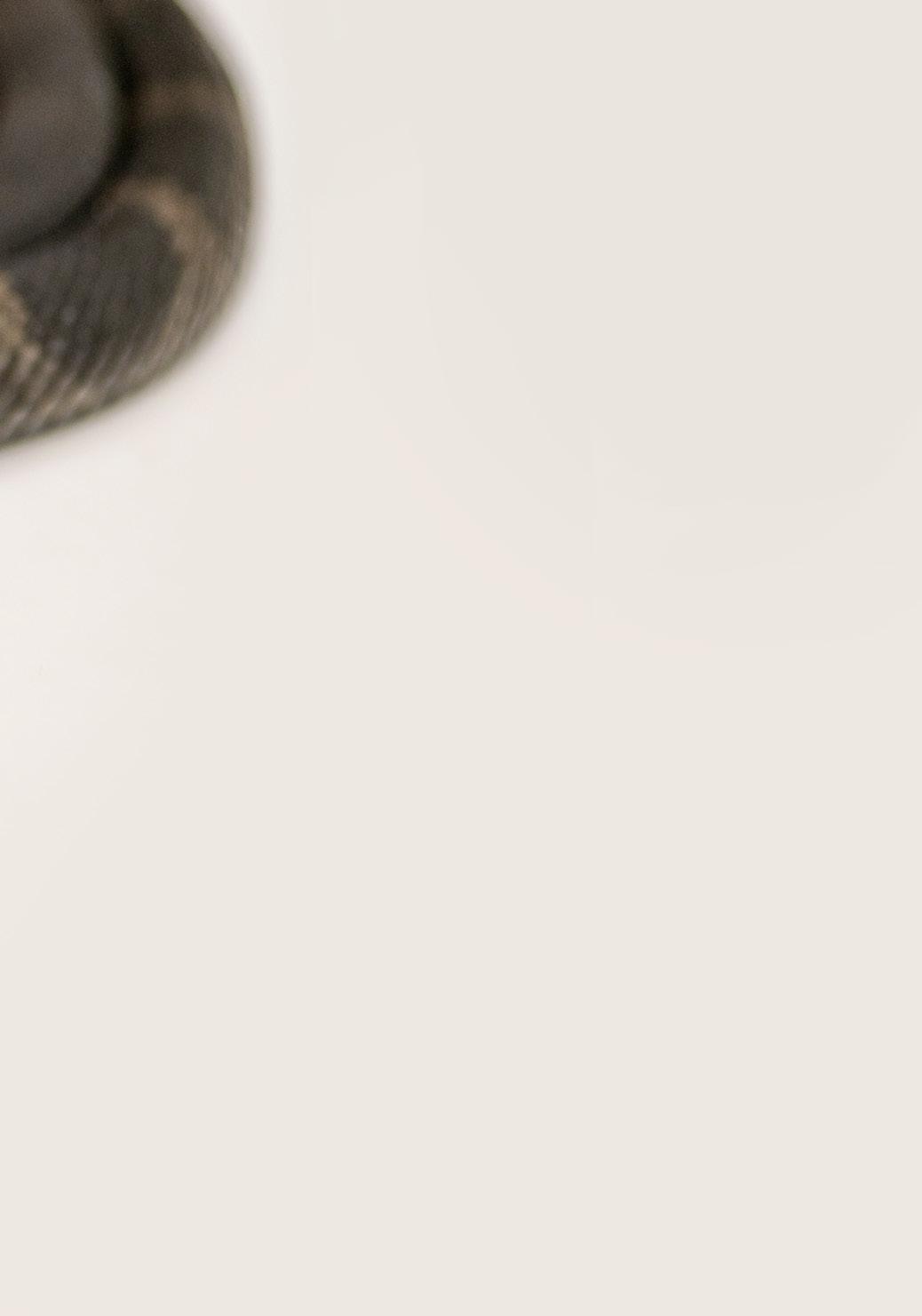
Around the Museum
Members’ preview of Sharks
The Members team was thrilled to welcome 600 of our community to this exclusive event on 24 September, to experience Sharks before it opened to the public. Kids and adults enjoyed a performance by the Obery Sambo and Meuram Murray Island Dance Group, donned Sharks hats, learned weird and wonderful shark facts with expert Will White and the DPI SharkSmart Team, sang along to Sydney Youth Orchestra playing Baby Shark and took selfies of themselves inside sharks jaws.
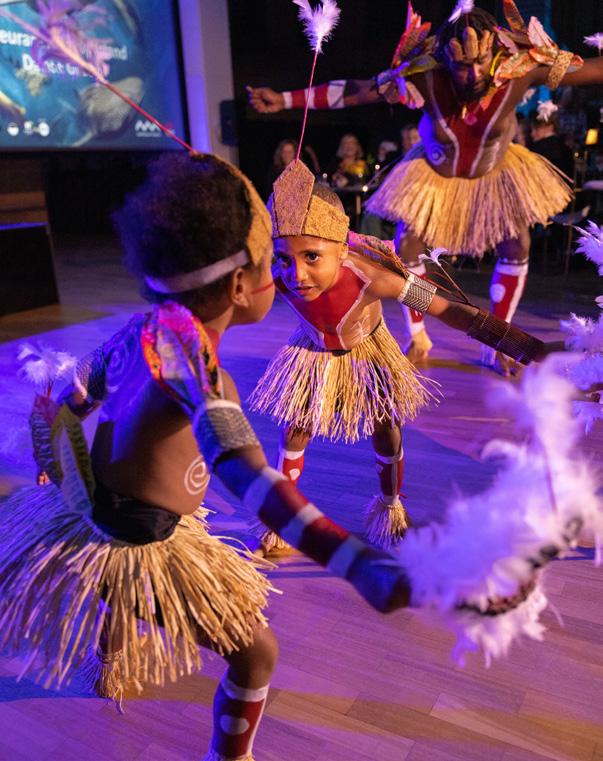
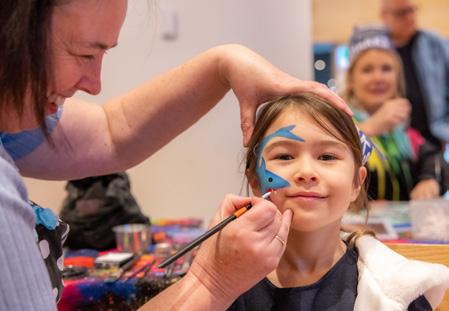
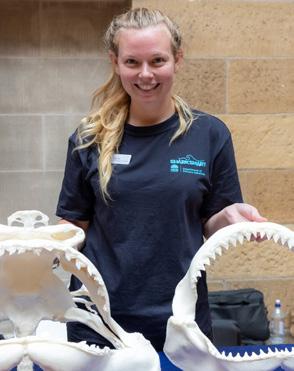
The 2022 Eureka Prizes
The 2022 Australian Museum Eureka Prizes
culminated in the celebration of 45 individuals and teams at a black- tie event on Wednesday 31 August. Held at the Australian Museum, the 400-person guestlist included finalists, prize partners, state government ministers and industry representatives. Formalities were delivered via a theatre-style presentation in Hintze Hall, with guests continuing the celebrations over drinks and canapés throughout the Museum’s gallery spaces. Award-winning science writer and presenter Bernie Hobbs hosted the evening, supported by multi-award-winning journalist, Rae Johnston, and Director of the Australian Museum Research Institute, Professor Kris Helgen.
Top: The 2022 Eureka Prize winners
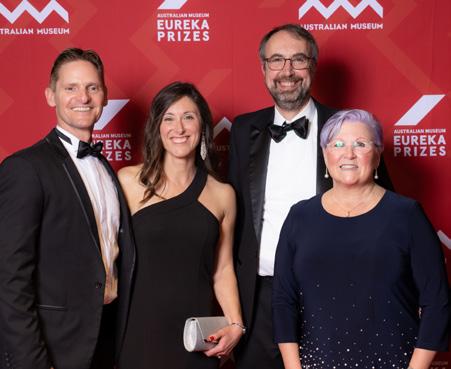
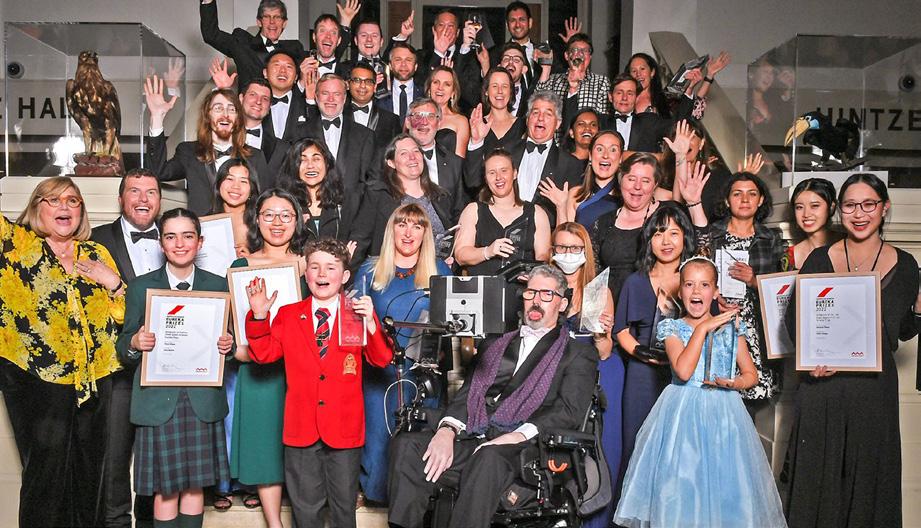
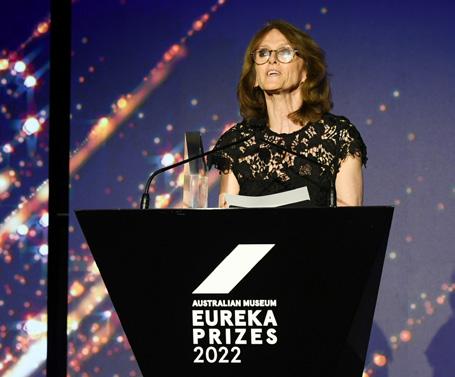
Middle: Australia’s Chief Scientist, Dr Cathy Foley AO PSM, presents the Department of Industry, Science and Resources Eureka Prize for STEM Inclusion
Bottom: Duncan Rennie, Associate Professor Kate Quinlan, Professor Merlin Crossley and Professor Margot Kearns
Photos by Tim Levy and Belinda Rolland
Donor frogging experience –FrogID week
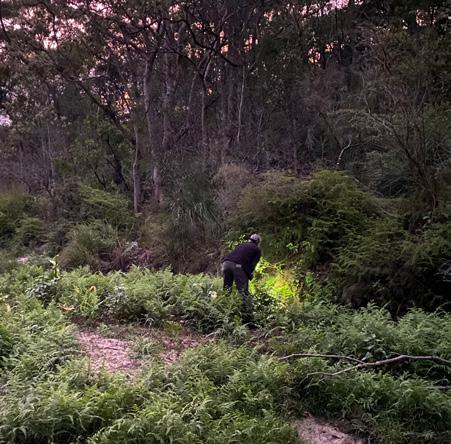
Guided by FrogID lead scientist, Dr Jodi Rowley, the development team hosted a small group of donors on a frogging experience at Manly Dam on 15 November. Held during FrogID Week, our donors were able to contribute to Australia’s biggest frog count, held annually to promote the recording of frog calls through the free FrogID app as a measurement of frog health and distribution around the nation. We were treated to a perfect November night – a little damp, just as the frogs like it – and were able to identify both the Common Eastern Froglet and Red-crowned Toadlet on our travels. With the support of philanthropy, we hope to expand the capabilities of the FrogID app and deepen its contribution to understanding frog biodiversity and conservation.
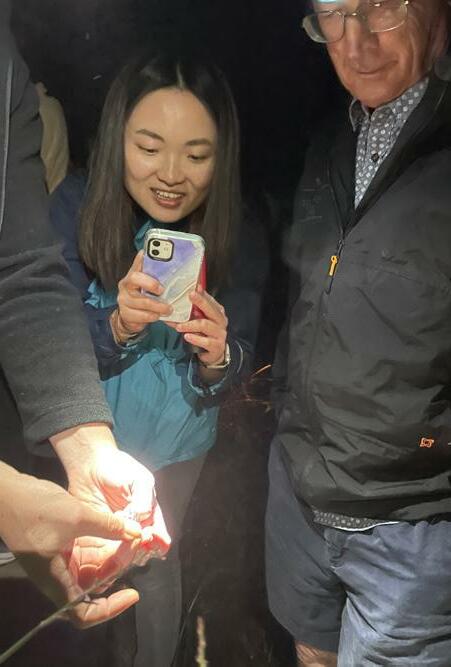
Donors and the AM development team on a frogging excursion with Dr Jodi Rowley. Photos by Amanda Farrar
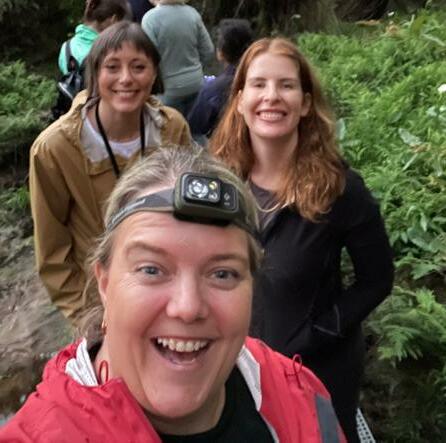
Australian Museum Donors and Partners
Leadership Gifts – Platinum
The Hintze Family Charitable Foundation
The Macdoch Foundation
The late Patricia McDonald
Leadership Gifts – Gold
Estate of the late Marjorie Helen Molesworth
The late Patricia Porritt Sherman Foundation
Patrons
David & Megan Armstrong
The Balnaves Foundation
The Carrawa Foundation
Estate of the late Clarence E Chadwick
Jennifer Crivelli Etheridge Descendants
Warwick Evans
Chris & Gina Grubb
Alison & Bill Hayward OAM
Mary Holt & the late Dr John Holt Anna Josephson & Rickard Gardell
Lansdowne Foundation Diccon & Elizabeth Loxton
Ann Macintosh Trust Memocorp Australia Pty Ltd Minderoo Foundation Neilson Foundation
The Paradice Family Foundation
Robert Rich
Brian Sherman AM & Dr Gene Sherman AM
Vonwiller Foundation
Estate of the late Cameron “Ivan” Walsh
Charles Warman Foundation
Estate of the late Gwendoline A West
Wollemi Capital Anonymous
Benefactors
Robert Otto Albert AO RFD RD
The John Spencer Dickinson Family
Claude & Maryanne Gauchat Belinda Gibson & Jim Murphy Ian Hardy Judy Lee
Catherine Livingstone AO & Michael Satterthwaite
Gretel Packer AM
Purcell Family Endowment Fund John T Reid Charitable Trusts
Estate of the late Eileen Silk Martin Terry Graeme Wood Foundation
President’s Circle
The Berg Family Foundation Crozier Family Fund
Drs Gary Holmes & Anne Reeckmann Bruce Jenkins
James N Kirby Foundation Kristina Stefanova & James Schultz
Dick & Pip Smith Foundation
Tony Sukkar AM & Josephine Sukkar AM Troy Suttor
Wavish Family Charitable Trust
Director’s Circle
Antoinette Albert Dr Charles Barnes Mike & Helen Cannon-Brookes Philip Chronican David & Mrs Juliet Clarke Louise Cox
Dr Zeny Edwards OAM
Hartzer Family Endowment Brian & Georgy Hartzer
Dr Janice Hirshorn & Dr George Jacobs
Rosemary Lucas
Jeffrey Simpson
Robyn Williams AO & Dr Jonica Newby
Su-Ming Wong Anonymous
Guardians
James & Mrs Belinda Allen Martin & Ursula Armstrong Alice Arnott Oppen OAM
Paul Bailey
K Barr
Ken & Roddy Bell Simon & Jordana Benson Robert & Linda Biancardi Christine Bishop
Jane Bridge & Michael Lambert Margot & Stephanie Chinneck
Paul Connor
Phillip Cordony
Phillip Cornwell & Cecilia Rice Margaret & Peter Donovan Lily W Mung Endowment
Amanda Farrar
Susan Foster Luke Harris David & Alexa Haslingden Kate Hayward
Amanda & Mark Hing
Dominique Hogan-Doran SC Peter & Louise Homel
Arthur Inglis
Fiona James Shauna Jarrett & The Hon Greg Pearce Dr Roderic Kefford AM Violeta Kelly Warwick Klabe
Estate of the Late Denis Stanley Klein John Leece AM
Elaine MacDonald Helen McCombie Kim McKay AO
Dr Marilyn McMurchie Stephen Neille Simon Perrott
Renee Pollack Foundation Judy Ranka & Bert Van Der Broek
Drs Jane & Neville Rowden Andrew & Jacqui Sherlock Fiona Sinclair
John Stitt & Christina Stitt-Ditfurth Dr Robin Torrence
Vera Vargassoff
Wendy Walker
Therese Wales & Agnes Chew Legacy Rachel White
Ray Wilson OAM
Stephen Wilson & Rachel Hawkeswood
The Yong Family
Principally funded by the NSW Government in association with Create NSW
Principal Partner Westpac
Major Partners Stockland
NSW Department of Primary Industries IBM Inspiring Australia
Supporting Partners Lindblad Expeditions –National Geographic WPP
IAS Fine Art Logistics Minderoo Foundation NSW Department of Planning and Environment – Water NSW Saving Our Species The NSW Biodiversity Conservation Trust
Strategic Partners Reconciliation Australia
Royal Botanic Gardens Sydney
University Partners Macquarie University University of New England
University of Technology Sydney
Media Partners
ABC Radio Sydney Australian Geographic
